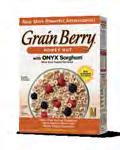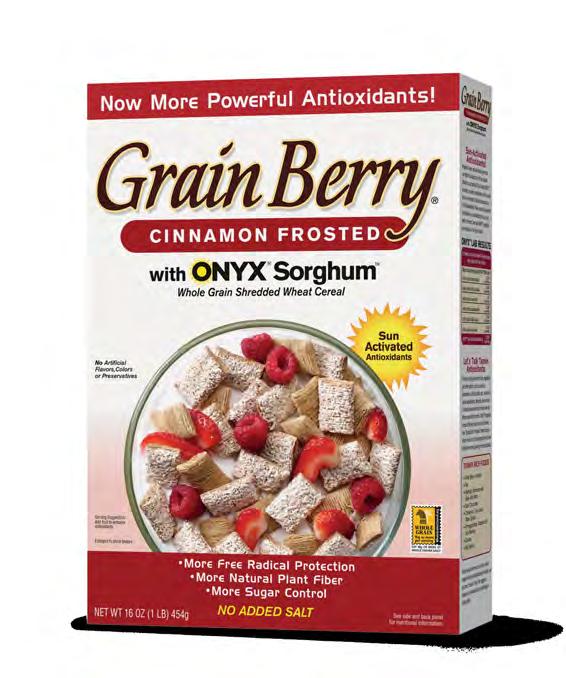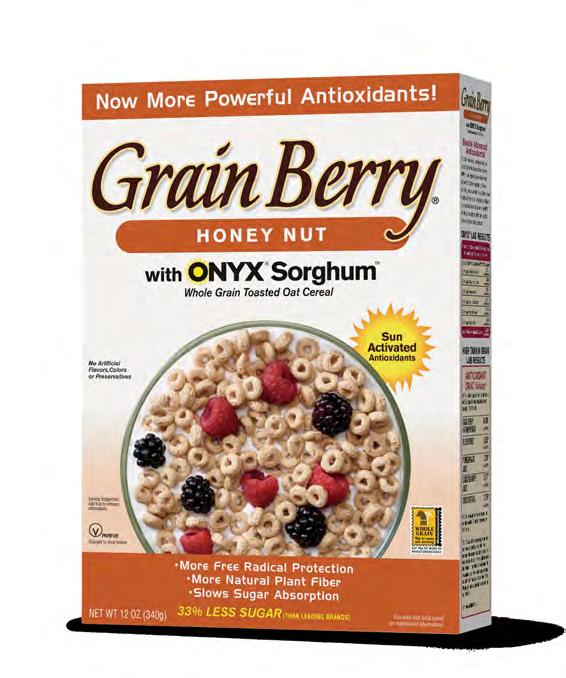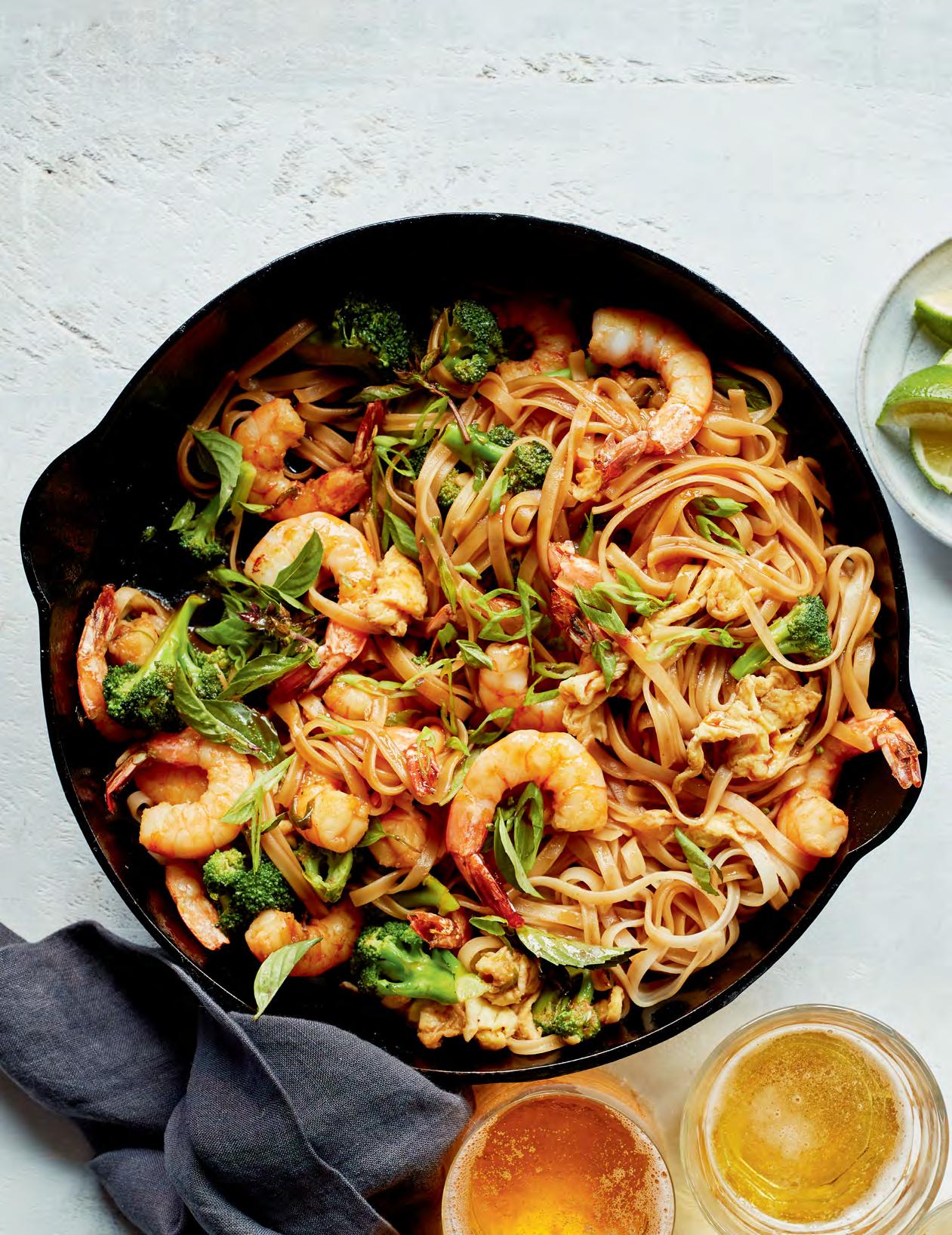




















































































































































It’s that time again when many of us dig into our list of New Year’s resolutions. If there’s anything that I learned in 2021, it’s not to take my health for granted. And one of the main ways I stay healthy is by eating well—and eating mostly plant-based. Studies consistently reveal the many health benefits of eating more plants, including losing weight; improving your cholesterol; reducing blood pressure; and decreasing the risk of type 2 diabetes, cardiovascular disease and certain types of cancer. There is also compelling research that a plant-based diet may slow the progression of Alzheimer’s.
You may notice the increasing availability of plant-based products at your local grocery store. According to numerous sources, grocery sales of plant-based products have grown 27 percent, and the market is set to top $74 billion by 2027. Four in 10 Americans have tried plant-based meat, and 41 percent of millenials are enjoying trying new plantbased foods and beverages at restaurants.
It’s a trend that is not abating.
Interested in giving plant-based eating a try? Then consider pledging to participate in Veganuary. Launched in the United Kingdom in 2014 and now recognized in countries around the world, Veganuary encourages people to try vegan for January and beyond . Simply sign up at veganuary.com and you’ll get a free e-cookbook, official Veganuary starter kit, daily recipes, meal plans, tips for eating out and ongoing support through an email series. There’s also a Facebook group with a supportive community full of people
making the transition at the same time or who participated in Veganuary in previous years.
More than 580,000 people from 209 countries took part in 2021.
98 percent of participants said they would recommend Veganuary to others.
40 percent of participants plan to stay vegan.
50 percent of participants experienced health improvements, including better energy levels, mood, skin appearance and body weight.
The Live Naturally website is chock-full of plant-based recipe options, including an ebook of vegan recipes, Vegan Delights. Head to livenaturallymagazine.com/vegan-recipe-ebook to download. Want to be more plant-based but don’t want to give up dairy? There are options! In this issue, we share all about the best plant-based milks, plus several great dairy-free butters and desserts for those of you with a sweet tooth.
As we launch into this New Year, we at Live Naturally will continue to work on researching and sharing ways to live a happier and healthier life. Wishing you all the best for 2022!
 Rebecca Heaton, Editor editor@livenaturallymagazine.com
Rebecca Heaton, Editor editor@livenaturallymagazine.com



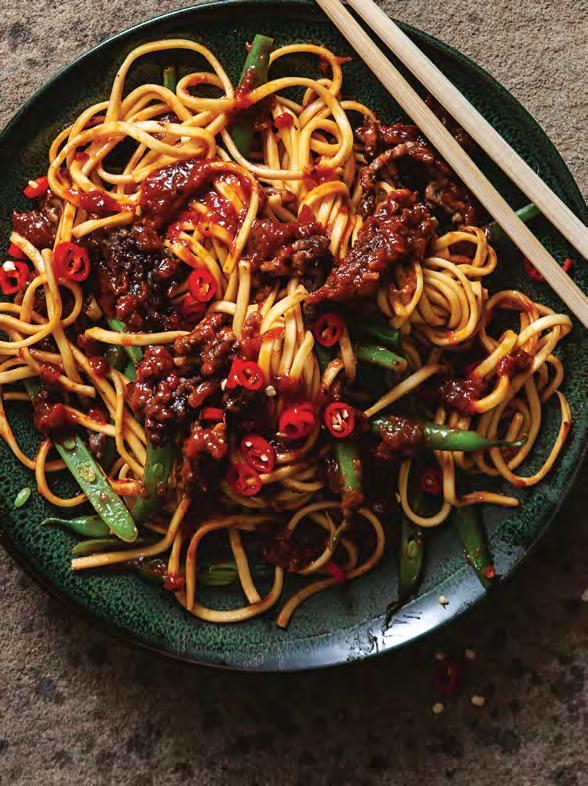





Part of the Live Naturally family of Kroger magazines
WINTER 2022 livenaturallymagazine.com
FAVORITE WAY TO DE-STRESS?
VICE PRESIDENT OF CUSTOM PUBLISHING
Brendan Harrington
VICE PRESIDENT & GROUP PUBLISHER
Deborah Juris EDITOR
Rebecca Heaton
CREATIVE DIRECTOR
Lindsay Burke
DESIGNER/DIGITAL
Shannon Moore
COPY EDITOR
Julie Van Keuren
KNITTING
DIRECTOR BUSINESS OPERATIONS

Devin Steinberg
CONTRIBUTING WRITERS
Lisa A. Beach
Nancy Coulter-Parker
Kathryn Leavitt
Sarah Protzman Howlett
Meghan Rabbitt
ADVERTISING SALES
Deborah Juris
PUBLISHED BY www.apg.alive.com 800.852.0857
Miyoko Schinner and her company Miyoko’s Creamery are leading the charge on creating delicious plant-based cheese and butter.
BY LISA A. BEACHWith plant-based diets soaring in popularity, Miyoko’s Creamery seems positioned as a leader in the vegan space. Launched in 2014, the California-based brand churns out artisan butter, cheese and other dairyfree products made from nuts, oats and legumes. Founder Miyoko Schinner started the company in her 50s after spending decades as a chef, cooking show host, gourmet restaurateur and cookbook author. We caught up with her to learn about her backstory and what’s on the horizon for her brand.

What inspired you to launch Miyoko’s Creamery?
I wrote a book in 2012 called Artisan Vegan Cheese (Book Publishing, 2012) that became a bestseller. Just like dairy cheese, making vegan cheese takes days of fermentation, brining and aging. People kept saying, “I love the vegan cheese, I love the way you’ve taught me how to make real cheese out of plant milk. But it’s a hassle—can’t you just start a company?” I heard that so many times that I finally just said, “OK, I’ll do it.”

How do your recipes’ proprietary methods make your vegan products different from competitors? We’ve expanded on the fairly rudimentary recipes in my cookbook and developed the commercialization piece of
it. We understand more of the science behind why certain plant milks—such as those made from oats, cashews and legumes— behave a certain way and how the proteins, fats and carbohydrates work. Most companies making vegan cheese just use oil and starch. We’re making plant milk, fermenting it and turning it into cheese on a large scale.
What advice can you give to others who aren’t vegan but want to eat more plant-based?
Everyone is a “pre-vegan,” on their own path to figuring out how they can change their diet to impact not only their own health, but
the health of the planet, other people and animals. The best thing we can do is provide them with not only information, but inspiration through recipes and different foods.
Forbes and the United Nations recognized you as a vegan revolutionary. What does this term mean to you?
I have the slogan “Phenomenally Vegan” tattooed on my arm. People asked why I used “vegan” because of its baggage. I’m trying to change that, to show that it’s phenomenal! When people go vegan, they enlarge their food choices, not limit them. They start discovering foods they never even thought about before. They also get healthier and become a
superhero because they’re saving animals and the planet. Being vegan is kind of like being in a club, where there’s a really deep connection based on a philosophical value of, “What can we do to make the world better?”
What’s next for your brand?
I’m going to be more visible in the brand. I’m also going to do more cooking shows. Last year, I did a one-hour Facebook Live show called “Miyoko’s Home Comfort” every day for four months, then three times a week, then weekly—for over a year. It was just me in my kitchen with my daughter filming me. I think that was part of the charm—it was so organic and real. So we’re going to do something a little bigger, professionally filmed.

ESPRESSO? LATTE? DECAF? The coffee you choose to drink may be related to your genetics, according to a study by researchers at the University of South Australia, who examined the habitual coffee consumption of close to 400,000 people and discovered that the type of and how much coffee we drink is likely to be an indicator of our cardio health. “People drink coffee for all sorts of reasons—as a pick-me-up, when they’re feeling tired, because it tastes good or simply because it’s part of their daily routine,” says lead researcher Professor Elina Hyppönen. “But what we don’t recognize is that people subconsciously self-regulate safe levels of caffeine based on how high their blood pressure is, and this is likely a result of a protective genetic mechanism.” Hyppönen notes that people who drink large amounts of coffee are likely more genetically tolerant of caffeine, while non-coffee drinkers, or those who drink decaffeinated coffee, are more likely prone to the adverse effects of caffeine, and more susceptible to high blood pressure. “This study shows that genetics are guiding our decisions to protect our cardio health,” Hyppönen says.
The order in which your senses interact with food has a tremendous impact on how much you like it. That’s the premise of a new study led by the University of South Florida. The findings, published in the Journal of Consumer Psychology, show that food tastes better if you see it before smelling it. Researchers conducted experiments with both food and beverages administered to participants in different orders: visual before scent, scent before visual, only visual and only scent. In one study, participants rated fruit snacks packaged in an envelope as tasting better when they could see the item before smelling it, compared with their counterparts who smelled the snacks before seeing them. The same results occurred with cookies and lemonade. “Scents play a critical role in influencing taste perceptions; however, people can process a scent better in their brains when it is preceded by a corresponding visual cue, such as color,” says researcher Dipayan Biswas.
Nitrates change into nitric oxide and, in turn, dilate your blood vessels and lower blood pressure.
Cardiovascular diseases are the number one cause of death globally, taking around 17.9 million lives each year. Recent research from Edith Cowan University in Denmark reveals that eating just one cup of nitrate-rich vegetables such as leafy greens and beetroot each day can significantly reduce risk of heart disease. The study examined data from 50,000 people over a 23-year period; those who ate the most nitrate-rich foods had a lower blood pressure and between 12 and 26 percent lower risk of heart disease. “Our results have shown that by simply eating one cup of raw (or half a cup of cooked) nitrate-rich vegetables each day, people may be able to significantly reduce their risk of cardiovascular disease,” says lead researcher Dr. Catherine Bondonno, adding that the study revealed participants also had a lower risk of heart attacks, strokes and heart failure. The easiest way to get your greens? “Add a cup of spinach in a banana or berry smoothie,” suggests Bondonno, but she advises not to juice greens because “juicing vegetables removes the pulp and fiber.”
PB8™ Helps Support the Immune System* and delivers digestive support with 10 billion beneficial bacteria per serving† in a proprietary blend of 10 probiotic strains, including Bifidobacterium lactis (Bl-04) and Bifidobacterium lactis (HN019).*
NO milk NO gluten
NO soy
NO eggs
NO peanuts
NO tree nuts
Do your digestive health a favor with the original PB8™ Probiotic formula that contains 8 strains of beneficial bacteria* comprised of 14 billion active probiotic cultures† such as Lactobacillus and Bifidobacterium. Available in gelatin or vegetarian capsules.
pb8probiotic.com
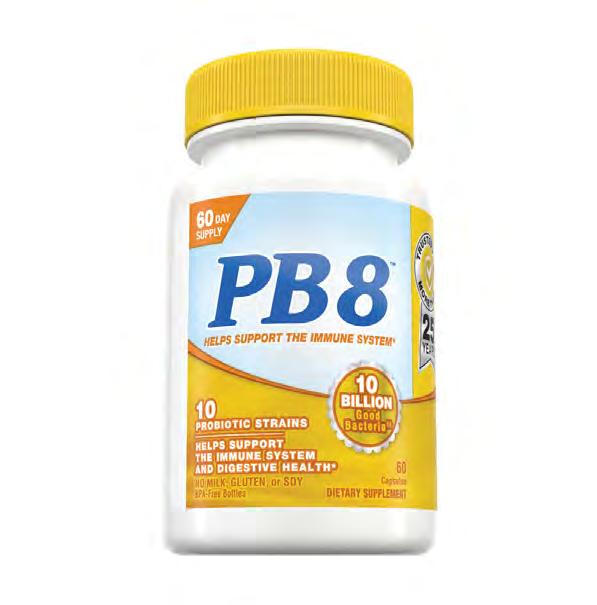
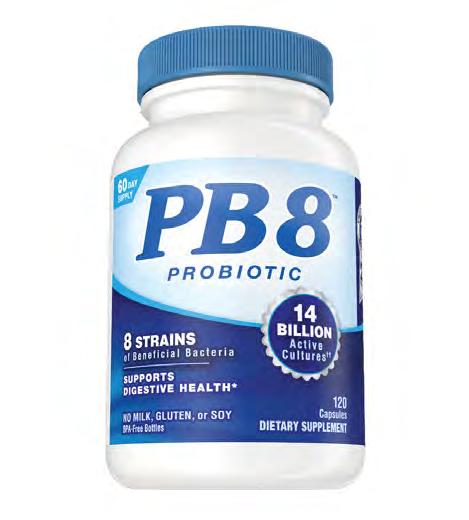

When you buy groceries, you’re buying their packaging, too. Here are some ways to make it greener.
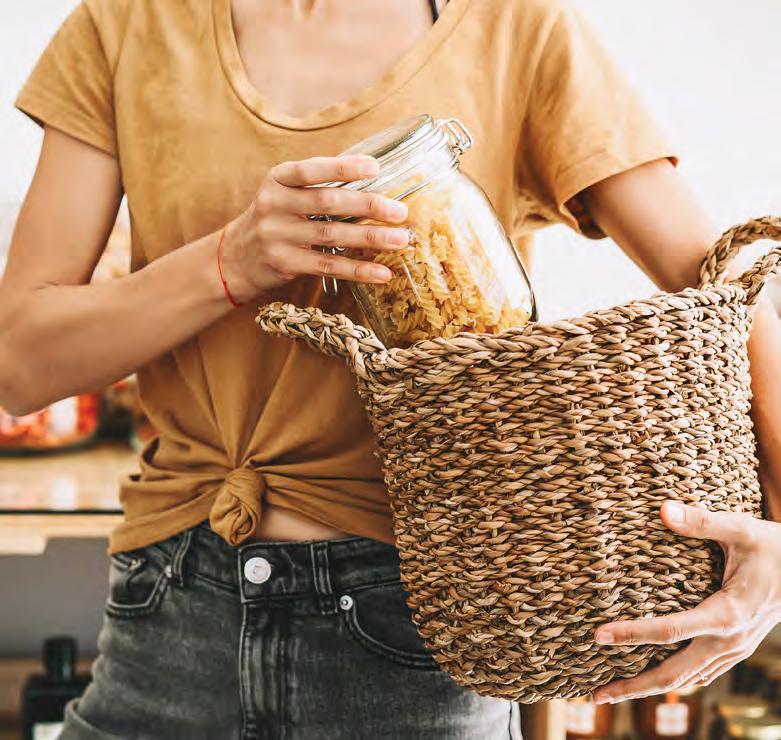 BY SARAH PROTZMAN HOWLETT
BY SARAH PROTZMAN HOWLETT
Awareness is growing around the environmental impact of packaged foods, both among consumers and the companies that make them. According to the Environmental Protection Agency (EPA), however, containers and packaging still make up over 23 percent of landfill material in the United States, some of which are food-related containers and packaging.
While recycling and composting can be complex due to city-bycity variances, it’s easy to tell just by looking which packaged-food purchases contribute the most to landfills, says Stephanie Moram, a sustainability consultant and creator of the website Good Girl Gone Green (goodgirlgonegreen.com) and the Green Junkie podcast. Moram’s number one tip? Avoid plastic when possible.
“It lasts forever in our environment,” she says. “It pollutes our water and our soil by taking years to decompose, and it can release toxins into the environment.” Further, plastic debris is often ingested by marine animals, and it can injure or poison wildlife, she says. And, sadly, 79 percent of plastic is never recycled, according to the journal Science
That said, if your favorite condiment still comes in a plastic bottle, keep a list on your phone of which plastics your local recycler takes, Moram suggests. The most common ones are Plastic #1 and #2, but your area may also accept others. Here’s what else Moram recommends for greener packaged food purchases.
“Cans are 100 percent recyclable,” she says. “Aluminum can continuously be recycled, actually, and doesn’t downgrade”—a term for reduction in quality when recycled again and again. And no, you don’t have to remove the wrapping or label from the can to recycle it. Just rinse and deposit!
Cereal, cookie and crackers boxes made from cardboard are sustainable, Moram says, because they can be reused (try boxing a small gift in one before wrapping!) and recycled. Check that the cardboard is not lined with plastic, Moram advises, as that can make it more difficult to recycle. If the box has a plastic film somewhere, like the window on the front of many pasta boxes, remove it before recycling.
Yes, it’s heavier and breakable, Moram says, but glass jars have all kinds of potential for a second life after that pasta sauce runs out. Brands like Classico pasta sauces and Bonne Maman jams are popular for reuse: Steam the labels off in the dishwasher and turn them into containers for iced coffee, homemade granola or leftovers.
Look for foods packaged in a way that do not appear to have an excess amount of weight, space or air. “It is a fine balance [for food companies] to make sure there is less waste but also ensure that the package arrives without damage,” Moram explains, adding, “but cereal companies could definitely make their packaging smaller to reduce waste.”
We are smitten with Zip Top Endlessly reusable—one Zip Top can save 5,000plus disposable bags—these platinumsilicone food containers stand up, stay open and zip shut when ready to seal. Made in the U.S., with a patented, award-winning one-piece construction (no more lids!), the durable containers are food-grade (aka, free of BPA, lead, PVC and phthalates) and microwave-, dishwasher- and freezer-safe. Buy at ziptop.com.

We’ve been turning to food as a powerful approach to health and healing for centuries. Here’s why.
BY MEGHAN RABBITTWhen Sudha Raj, Ph.D., R.D.N., a professor in the Department of Nutrition and Food Studies at Syracuse University, considers the many ways food can be used to optimize health and healing, she thinks of Hippocrates’ quote: “Let food be thy medicine and medicine be thy food.”
“Cultures across the world have been turning to food to help them heal since ancient times,” says Raj. In fact, migrating tribes focused on food sources when they decided where to settle, adds Elizabeth Somer, R.D. “Even when we were living in caves or rock shelters, we were identifying local foods that were good or bad, tasty or poisonous,” she

By now, you’ve heard that inflammation is the root cause of almost every disease we deal with these days, from heart conditions and diabetes to cognitive decline and even cancer. Your body’s inflammatory response is actually a good thing; it’s what your immune system does when it comes in contact with a germ, virus or some other threat to your health. However, a nutrient-deficient, sugar-rich diet and unhealthy lifestyle habits prompt near-constant inflammation, causing the kind of chronic inflammation that leads to disease. The good news is that certain foods can stop this unhealthy inflammatory response, says Raj. “Vegetables and fruits contain powerful anti-inflammatory nutrients that can help to heal the body.”
says. “This food history soon expanded to the belief that food could treat ailments.”
There are many reasons why this belief proved to be true: The foods we eat can help determine whether or not we stay healthy as we age, and can even help us fix things like nutrient deficiencies and chronic internal inflammation that can cause disease, says Josh Axe, D.N.M., C.N.S., a doctor of natural medicine and a clinical nutritionist.
“There are a number of ways foods can protect us against disease and slow the effects of aging,” he says. Here are a few of the ways foods can both optimize your health and help you heal.



Many of the ailments we deal with today are due to a buildup of toxins from both the food we eat and the environment in which we live. And here’s the good news: You don’t need to do a juice cleanse or buy a small army of expensive supplements to “detox,” as some people would have you believe. Your body is well-equipped to eliminate toxins on its own—and certain foods can help you enhance that natural process, says Raj. Sulfur-containing foods like broccoli, onions and garlic have been shown to be particularly helpful when it comes to enhancing your body’s excretion of heavy metals. Also, make sure you’re drinking plenty of water, which aids digestion and absorption of nutrients, and also helps your body get rid of what it doesn’t need.

When you eat, the body makes insulin to help move the glucose from your food into your cells so it can be used for energy or stored for later. However, if you eat too much food—and especially if you consume too many glucose-rich foods (read: too much sugar)—your body can struggle to make enough insulin to move that glucose, and it can build up in your bloodstream. This can lead to diabetes. However, food can be a powerful way to regulate your blood sugar naturally, ultimately helping you stave off or treat diabetes. Leafy greens and other non-starchy veggies, whole grains, legumes and lean protein are all great foods to help balance blood sugar, says Raj.
We want to help you eat better!
Live Naturally and Kroger Health’s team of registered dietitians have teamed up for a series on nutritious foods, their health benefits and how to cook with them. Head to livenaturallymagazine.com and click on the Lifestyle tab/Food as Medicine.
Meet two farmers who make caring for creatures and the planet—and producing the best-quality products—a priority.
BY NANCY COULTER-PARKEREric Wedel grew up around chickens. When he was 16, his dad got into the poultry business in Missouri, producing broiler chickens for a large poultry company. Wedel took a slightly different path, training to do the electrical work and wiring for different egg and chicken barns in the region. It’s safe to say, whether he was on his dad’s farm or doing his own work, he saw a lot of chickens—and he could recognize the happy ones.
In 2019, Wedel decided to start his own pasture-raised egg farm, Wild Wood Acres, and joined with Vital Farms, which partners with more than 200 farms to bring ethically produced food to the table. “It’s interesting to see our barn in comparison to what I grew up with; I was used to seeing chickens inside their whole life,” says Wedel, whose farm sits on 50 acres with the barn in the center. There, his 20,000 chickens move through a pasture

rotation, which allows them to forage on a section of the land, giving other parcels time to rejuvenate naturally without pesticides or herbicides. Hens spend the day in the pasture and only come in at night to avoid being eaten by natural predators.
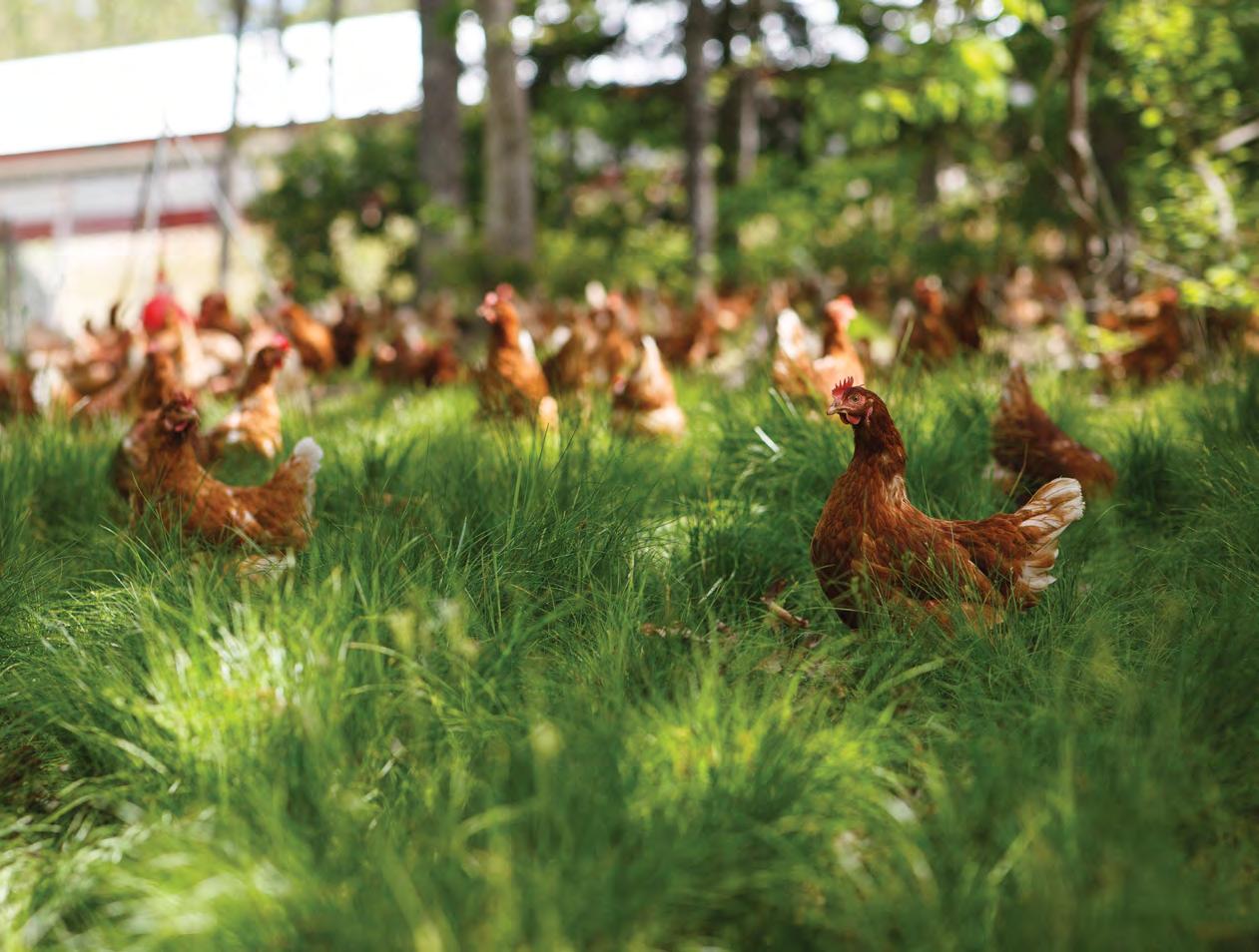
Wedel’s farm is situated in what is known as the pasture belt, a region of the U.S. with warmer weather and mild winters that allows hens to have outdoor access year-round. All Vital Farms eggs are produced by pasture-raised hens, meaning every hen gets a minimum of 108 square feet to roam and forage with access to fresh air and sunshine. Wedel says he could immediately tell his chickens were enjoying their surroundings. “You just have to listen to them to know how they are feeling. They are cooing and
happy and enjoying the sunshine.” And they are more responsive, too. “These chickens are much more friendly. They love to be held and petted, and they all follow you around,” he adds, something he wasn’t used to with indoor chickens.
Whether you’re eating a carrot, a cracker or a protein powder, it’s important to think about the quality of the soil where the ingredients of your food or supplement originally grew. Soil is not always top of mind when we grocery shop—but it should be. At the Center for Regenerative Agriculture & Sustainability, a 110-acre farm in Middle, Tennessee, that is also the new company headquarters for Ancient Nutrition, makers of nutritional powders and products, soil is a top priority.
“Most of the things we do on the farm are about improving the soil,” says Ancient Nutrition farm director, Todd Vincent, who explains that just like the human gut, the soil has its own microbiome that is teeming with life. “I’ve had to learn to become partners with nature and not try to control it. I have stopped trying to bring nutrition to the plant, but to bring it to the soil microbe because they know how to divvy it up to the plant way better than I could do it. It is much simpler when you partner with nature’s system, and that is letting the soil’s microbes do all that work for you.”

Vincent oversees the farm’s operations, managing more than 110 varieties of tropical plants and herbs and 30-plus varieties of indigenous trees, shrubs and vining plants, all of which contribute to the

establishment of a Million Member Regenerative Food Forest. The plants are either used in Ancient Nutrition formulations or in research and development for possible end use, with the goal being for every Ancient Nutrition product to have a regenerative story. Ingredients that aren’t found on the farm can be sourced from the 4,000-acre Missouri-based Beyond Organic Ranch and Heal the Planet Farm, owned and operated by Ancient
Jordan Rubin and Dr. Josh Axe.
Ultimately, all of this work ladders up to support Ancient Nutrition’s R.A.N.C.H. Project, which is based on the company’s commitment pillars: regenerative agriculture, nutrition and climate health. By tending to the soil using organic, regenerative practices, the plants garner enhanced nutrition while at the same time pulling carbon from the atmosphere and sequestering it in the soil to help offset global warming.
As a complement to other Vital Proteins products (including powders, waters, shots and bars), gummies provide a nice add-on to your current wellness routine. Start your day with a scoop of Vital Proteins Collagen Peptides in your morning coffee, then take your gummy later. Because the ingredients don’t overlap, you can take all six types of gummies together or pick and choose based on your unique needs. All gummies are free of synthetic colors and artificial flavors and made without soy, gluten or dairy.
With a busy life, it can be challenging to keep up with your wellness and beauty routine. The solution? Vital Proteins Wellness Gummies to the rescue!

The gummies add a bitesized, delicious boost to your wellness goals. Want to increase your daily collagen intake or elevate your beauty game? There’s a gummy for both. Looking to improve your sleep**, support your immune health**, or boost digestion**? You’ve got options. And if you want to support overall wellness**, there is a powerful multi up to the task.
Gummies are convenient, too! Since you don’t need water to wash them down, take these gummies to go as you head out the door for the day. Plus, they’re easy to chew, easy to digest (great for sensitive tummies), and just as effective as supplements in pill or capsule form. Did we mention they’re bursting with flavor? The fruit-flavored gummies (think strawberry and apple) feel like a tasty snack, adding more variety to your daily eating plan. Most importantly, all six Vital Proteins Gummies nourish your inner glow.
Note: While only the Vital Proteins Collagen Gummies contain collagen, all of the gummies contain gelatin, so they’re not vegetarian.

Be a glow-getter at every age! Make some strawberryflavored Beauty Gummies part of your daily wellness regimen. Loaded with glowing ingredients—like vitamin A and biotin—these gummies are designed to increase skin hydration ** and promote a youthful appearance **. With beauty-centric nutrients squeezed into each bitesized nugget, these gummies can make you look and feel more radiant and beautiful **. Shine on!
What’s Inside
2 Gummies: Biotin, Vitamin A, Antioxidant Vitamins and Minerals, 2 g Sugar
Benefits:
• S upports healthy skin, hair and nails **

• Increases skin hydration **
• Promotes strong hair and nails **
• Promotes a youthful appearance **
Did you know that, starting around age 25, your body produces less collagen? As an important building block in your body, collagen helps support healthy hair, nails, skin and joints**. Vital Proteins Collagen Gummies, made from grass-fed bovine, can give your body a collagen boost as you age. And they contain Verisol collagen—a patented collagen different than Vital Proteins' Collagen Peptides. Clinically shown to reduce fine lines and wrinkles^, Verisol packs an effective, potent amount of collagen so you don’t have to take too many gummies— giving you more bang for your buck.
What’s Inside 4 Gummies: 2.5 g collagen, 5 g sugar
Benefits:
• Increases hair thickness **
• Reduces fine lines and wrinkles **
• Increases skin elasticity **
These delicious, bite-sized gummies empower your wellness routine like a (multi-tasking) boss. Bursting with flavor (who doesn’t love raspberry?), the Women’s Multi Gummies boast functional ingredients in every morsel. They are specifically designed with key nutrients that boost energy , support metabolism** and maintain immune health**
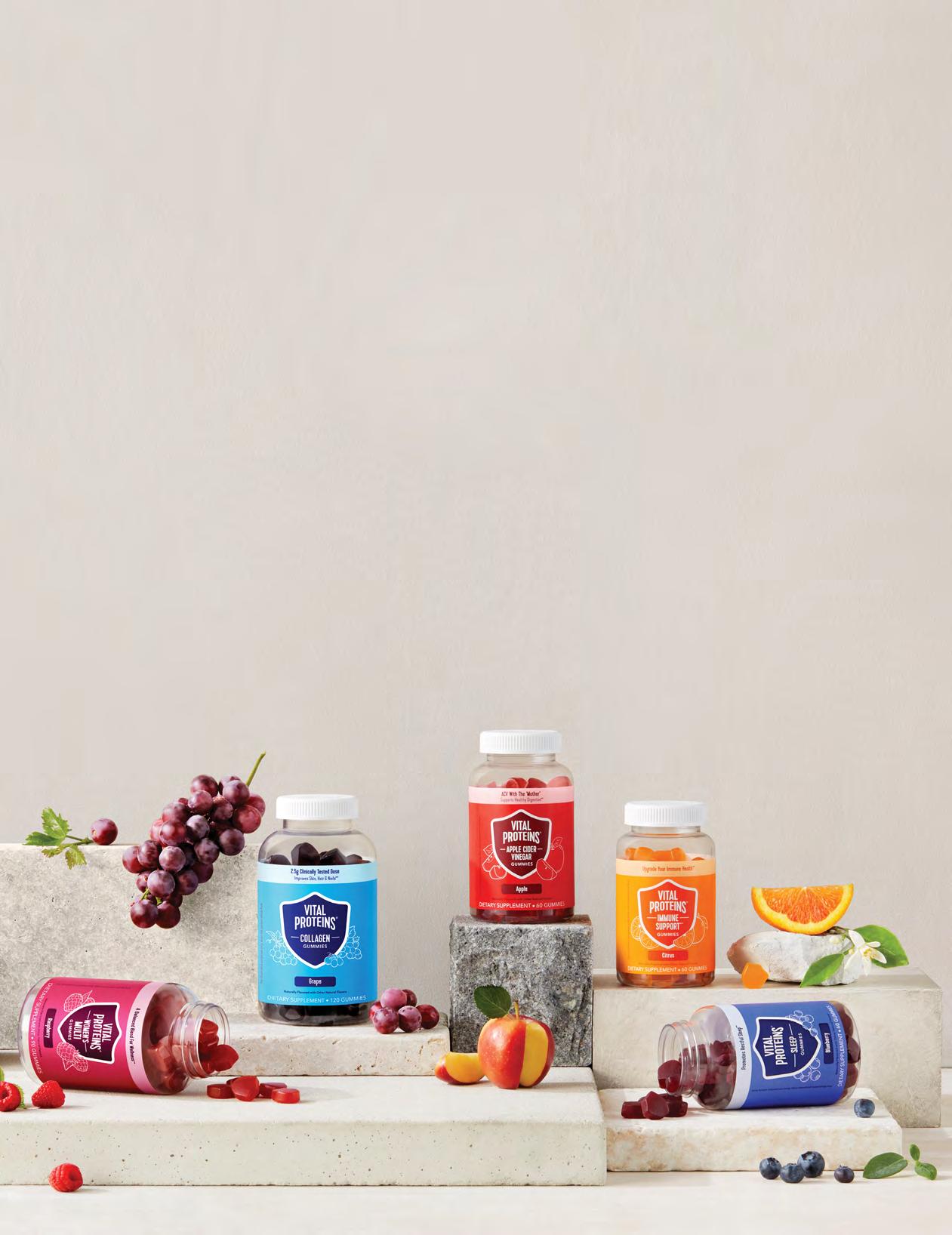
What’s Inside 2 Gummies: Vitamin D, Biotin, Vitamin B12, Vitamin B6, 2 g Sugar
Benefits:
• Boosts daily energy**
• S upports immune health **
• Supports metabolism **
• S upports bone health
Your digestive (a.k.a. gastrointestinal) system works as the body’s “other brain” and plays a pivotal role in your wellbeing from head to toe. Trust your gut health to some Apple Cider Vinegar Gummies. Bursting with goodfor-you nutrients (like vitamin B12 and folate), these bite-sized gummies help support your gut and immune health** and boost energy . Appleflavored (of course!), these gummies contain the “mother,” a beneficial combo of protein, enzymes and bacteria that boosts digestion** and energy.
What’s Inside 2 Gummies: Apple Cider Vinegar, Vitamin B12, 4 g Sugar
Benefits:
• Supports gut health**
• S upports immune health **
• Aids in digestion
• Boosts daily energy **
Refresh your wellness routine— morning, noon, or night—with some citrus-flavored Immune Support Gummies. Chockfull of functional ingredients (like zinc, vitamin C and ginger), these gummies support your immune health**. Key to your wellbeing, a properly functioning immune system helps fight illness and stave off sick days —and that’s nothing to sneeze at.
What’s Inside
2 Gummies: Vitamin C, Zinc, Vitamin D3, Selenium, Ginger Extract, 2 g Sugar
Benefits:
• S upports immune health
Talk about a snoozefest everyone will love! Slip into better sleep and wake up feeling rested ** with blueberryflavored Sleep Gummies. Boasting dreamy ingredients (think melatonin, L-theanine, and vitamin B6), these nighttime nuggets protect your getsome-shuteye wellness routine. Take Sleep Gummies just 15 minutes before bedtime to join the slumber party!
What’s Inside
2 Gummies: Melatonin, Vitamin B6, Vitamin B3, L-Theanine, 3 g Sugar
Benefits:
• S upports healthy and restful sleep **
• Makes a convenient bedtime routine
For those “hangry” times in between meals, or when you need an energy boost or an afternoon pick-me-up, a healthy snack can do the trick. Here are three of our favorites.
BY REBECCA HEATONIt all started during a hike on Mount Rainier when Josh Schroeter and Edmond Sanctis were enjoying the views…but not their snacks. So they decided to start their own snack company, and Sahale Snacks was born. The brand is named after Sahale (pronounced sa-HA-lee) Mountain, a popular climb in northern Washington state. Their savory, plant-based Bean + Nut Snack Mixes with 5–6 grams protein per serving are inspired by destinations around the world—Tokyo, New Orleans, Rome and more—with sophisticated, all-natural ingredients like dry-roasted nuts, roasted chickpeas, fava beans, pepitas, crisped brown rice, and unique spices to satisfy even the pickiest of foodies. The newest flavor is Harissa, made with the popular hot pepper chili paste native to northern Africa.

Available in: 1.25-ounce and 4-ounce resealable pouches.
Flavors: Harissa, White Cheddar Black Pepper, Creole
Chickpeas aren’t just for hummus and falafel anymore. Created by betterfor-you food innovator Livio Bisterzo, Hippeas are a healthier alternative to traditional cheese puffs. Made from chickpeas—which contain fiber, calcium and magnesium—plus rice and brown rice flours and pea hull fiber, a serving of crunchy Hippeas contains 3 grams of fiber and 4 grams of plant-based protein with zero grams of cholesterol and no trans fats. A feel-good fact: For every bag sold, Hippeas donates to Farm Africa, a charitable organization that works with farmers in East Africa to provide a way for the people in SubSaharan Africa to grow out of poverty and make the most of their land. Available in: 4-ounce, 6-ounce and 10-ounce pouches.
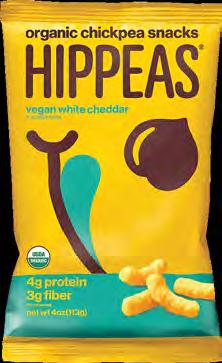
Flavors: Vegan White Cheddar, Bohemian Barbecue, Nacho Vibes, Sriracha Sunshine
While many granola and energy bars are high in processed sugar, Kate Real Food bars are sweetened with organic honey and dried fruits like cherries and mango. An avid outdoorswoman and skier, Kate Schade perfected her recipe for a healthy energy bar to satisfy a personal need to stay fueled during her outdoor adventures—as well as share with active friends. It didn’t take long before she established a loyal following. Available in an array of flavors, the bars are made with great-tasting, wholesome, organic ingredients with no chemicals or artificial sweeteners, with 3 grams of protein and 8–9 grams of sugar, depending on the flavor.

Flavors: Lemon Coconut, Mango Coconut, Dark Chocolate Cherry & Almond, Peanut Butter Milk Chocolate, Peanut Butter Dark Chocolate
O NG GF


It’s fast + fun, with zero commitment!
Looking for a fast-and-easy sauce to spice up your noodles? Open a jarred pasta sauce—healthy options abound!
 BY REBECCA HEATON
BY REBECCA HEATON
Over the past year, many of us have sought comfort spending time in the kitchen—and that’s not a bad thing. According to the International Food Information Council, 8 in 10 Americans say they have altered their food habits as a result of the COVID pandemic, and 6 in 10 people say they are cooking more at home. One of the most popular at-home recipe trends? Pasta! And what is a pasta dish without a delicious sauce? If you’re not up for making a sauce from scratch, there are plenty of store-bought options to choose from. Here are some of our favorites to stock in your pantry.
Source: SFA
Launched in 1877, Barilla is a true pioneer in Italian foods. Their pesto sauces begin from the fragrant fields of fresh basil growing near the company’s hometown of Parma, located in northern Italy's EmiliaRomagna region, famed for (appropriately) Parmesan cheese. Along with basil, the sauces are made with 100 percent extra-virgin olive oil, freshly grated Italian cheeses, cashews and salt.

TRY Rustic Basil, Creamy Genovese

Silver Palate’s pasta sauces start with high-quality whole peeled tomatoes— not paste. They slow simmer a blend of tomatoes grown in the rich volcanic soil of the San Marzano region of Italy, along with fruit grown in the fertile central valley of California. Other ingredients are basic and fresh: extra-virgin olive oil, basil, onions, carrots, garlic and spices, with no added sugars and just a dash of salt.
TRY San Marzano Marinara, Low Sodium Marinara

Source: SFA
Made with organic, California-grown tomatoes and avocado oil—full of antioxidants and healthy fats such as oleic acid, which supports heart health—these sauces are both nutritious and delicious. With no added sugars, all sauces are vegan, gluten-free, non-GMO, certified paleo and keto, and Whole30 approved. The creamy and flavorful plant-based alfredo sauce is made with cashew butter.
TRY Tomato Basil Marinara, Roasted Garlic Marinara, No Dairy Alfredo Sauce

A year of home cooking has led to consumers rediscovering the usefulness and necessity of a home pantry.
Shelf-stable sauces were one of the top 10 fastestgrowing categories in 2020.
Driven by the pandemic’s effect on buying , at-home meal prep and consumption, specialty food sales soared to a record $ 170.4 billion

in 2020, according to the Specialty Food Association’s (SFA) annual State of the Specialty Food Industry report.

PLANT-BASED
Recently launched in the U.S., Wicked Foods is on a mission to “unleash the mighty flavor of plants.”
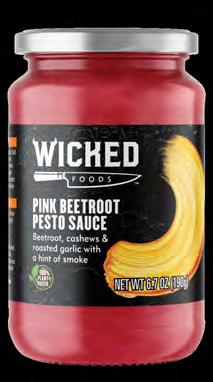
Founded in 2012 in the United Kingdom by chefs and brothers Derek and Chad Sarno, the brand offers a selection of creative, delicious, 100 percent vegan pesto sauces that veer from the standard basil pesto recipe—chef-driven flavors like pumpkin, beetroot and black olives. Other “unorthodox” ingredients (that work!) include cashews, tofu, pea fiber, carrot fiber, curry powder, lemon peel and sunflower oil.
TRY Black Olive Pesto Sauce, Orange Pumpkin Pesto Sauce, Beetroot Pesto Sauce
One of the best things about Simple Truth sauces is that they are all USDAcertified organic, non-GMO and free of any and all artificial ingredients. Red sauces are made with tomato puree and diced tomatoes and extra-virgin olive oil, plus a plethora of spices, including garlic, oregano and fennel. Rich alfredo sauces contain cream, corn starch and Parmesan. For vegans, a plant-based alfredo is made with soy milk, cauliflower and nutritional yeast.
TRY Tomato Basil, Marinara, Vodka, Classic Alfredo, Plant Based Alfredo
One of the unique qualities of this brand is that 100 percent of profits go to charity, thanks to founder and actor Paul Newman, who dubbed his sauces “an intimate companion your pasta will never forget.” Red sauce ingredients are simple and basic: tomato puree, diced tomatoes, extra-virgin olive oil and spices, while the creamy and cheesy alfredo is made with cream, several cheeses, whey and spices.

TRY Marinara, Tomato & Basil, Sockarooni, Alfredo
Named after naturalist, author and Sierra Club cofounder John Muir, this brand has been committed to organic farming from the start. Tomatoes for all their sauces are sourced from six organic farms in the Sacramento Valley of California, and the company is committed to helping farmers with regenerative agriculture practices and increasing organic farmland. Sauces are non-GMO with no added sugars and are made with all-organic tomatoes and tomato puree, extra-virgin olive oil, onions, garlic and spices.
TRY Tomato Basil, No Sugar Added Garden Vegetable, Portabella Mushroom, Italian Herb
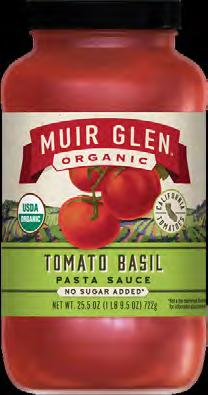
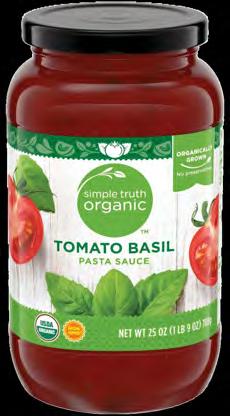


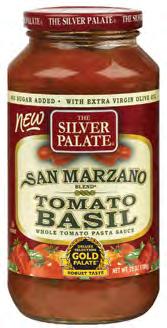
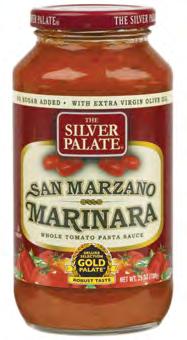



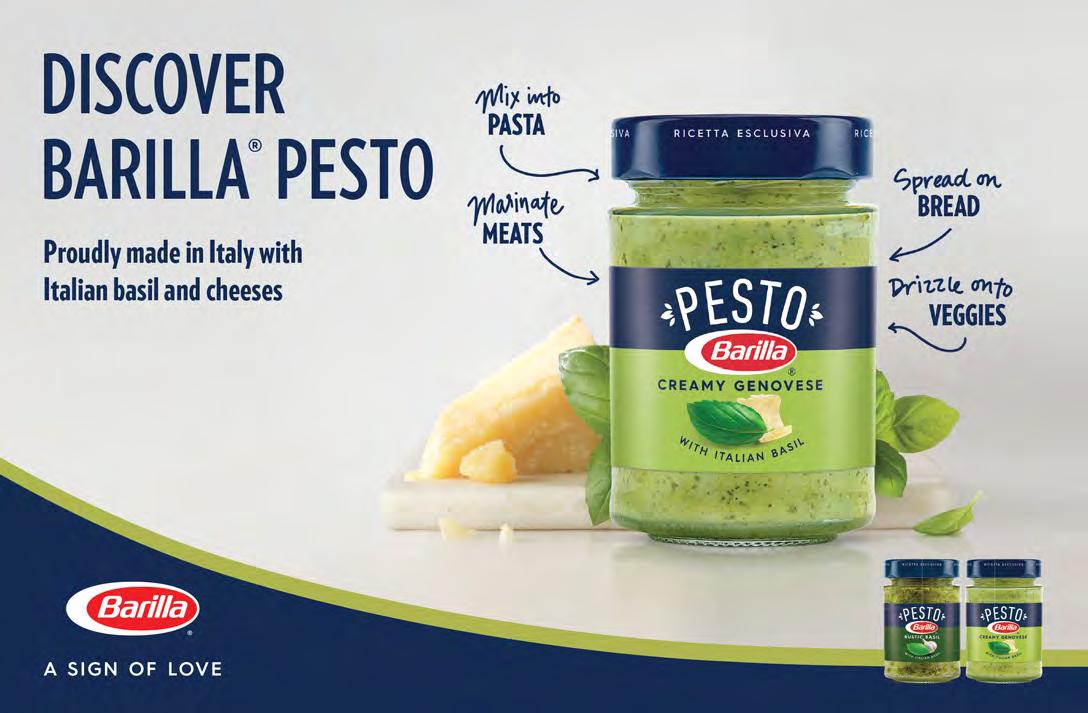
Gone are the days when buying milk was a decision between whole, low-fat or skim. Today’s milk aisle is now laden with cartons filled with dairy-like options made from plants—soy, almonds, oats, peas, coconuts, rice and more.
*
When buying plant-based milk, be sure to examine the nutrition label because some milks may not be as healthful as they seem.
According to the Good Food Institute and market research firm SPINS, nondairy milks are worth $2.5 billion of the $7 billion plantbased foods market. And while cow’s milk is still the most popular according to retail sales, plant-based milks grew 54 percent over the past five years—and they’re still growing.

So what’s the deal? It’s tied to a few factors. The first is lactose malabsorption—the intolerance we didn’t know we had. According to the National Institutes of Health, about

36 percent of the U.S. population has some degree of lactose malabsorption, when your small intestine cannot digest, or break down, all the lactose you eat or drink. In lay terms, dairy products just don’t sit well in many of our stomachs. Enter plant-based milks as a replacement.
But it’s not just about lactose intolerance. According to the 2020 ProVeg International Plant Milk Report, people choose plant milks over animal milks for a variety of reasons—whether it is for their nutritional value, animal welfare, lower environmental impact, to avoid dairy-milk allergens or simply out of personal preference.
The established industrial process for making nondairy beverages, according to ProVeg, is to soak the legume, nut, grain or other main ingredient in water and then press and strain the liquid or “milk.” Some plant-based
milk ingredients can also be ground in their dry form and then blended with water. Depending on the product and manufacturer, additional ingredients such as oil, sugar, flavorings and stabilizers are added to make the milk more palatable.
The next step—similar to cow’s milk—is homogenization and heat treatment to crush any fat globules and disperse them uniformly through the milk, resulting in a smoother drink. To increase shelf life and emulsion stability of plant milk, different heat treatments such as pasteurization (less than 212°F) or ultra-high temperature treatment (275–300°F) are used. Additionally, manufacturers often fortify their plant milks with calcium, vitamin D, vitamin B12, omega-3 fatty acids and/or other added nutrients. »
The plant-based milk category is booming. We share why, how the different milks are made and what’s in them nutrition-wise.
According to SPINS, the six most popular plant-based milks from the past year (based on sales) are soy, oat, almond, pea, coconut and rice. Depending on the type and brand, plant-based milks are available refrigerated and/or shelf stable (not refrigerated). Once a shelf-stable box is opened, it needs to be refrigerated.
Soy milk is made from soybeans. When fortified with calcium and vitamins A and D, it is the only milk alternative that is comparable to cow’s milk in terms of nutrition. In contrast with dairy milk, soy milk contains low levels of saturated fatty acids and high amounts of unsaturated fatty acids, both of which can, according to studies, lower LDL cholesterol levels and reduce risk of coronary heart disease. Several studies have shown that consuming soy can help reduce the risk of some forms of cancer and osteoporosis.
1 cup unsweetened contains: 80–100 calories; 7 g protein; 4 g fat; 4 g carbohydrates
Other nutrients: potassium, omega-3 fatty acids, isoflavones. (While there has been some concern that soy isoflavones may raise the risk of breast or endometrial cancer, recent studies find no negative effect.)
TRY WestsoyThe most popular plant milk, according to SPINS, almond milk is made from ground almonds. Very low in saturated fat—about 96 percent less than whole dairy milk—almond milk is also low in calories. One disadvantage of industrially manufactured almond milk is that the protein content of the nuts is filtered out together with the pulp, which leaves only around 0.5 percent protein in the milk. Research indicates that almond milk can be a particularly good solution for children suffering from allergies or intolerances to animal milk.

1 cup unsweetened contains: 40 calories; 2 g protein; 3 g fat; 1 g carbohydrates

Other nutrients: vitamin E, a disease-fighting antioxidant
You should avoid this milk if you are allergic to tree nuts.
TRY CalifiaAccording to a new Polaris Market Research report, oat milk is the fastest-growing plant milk, with sales projected to grow almost 10 percent annually over the coming years. Made from raw oats, it is high in vitamin B12 and calcium, with some fiber (unfortunately, the beneficial fiber in oats is mostly lost in the milk production process). Because sugar is a natural component of oats, this milk tastes slightly sweet. It’s ideal for those with dietary restrictions or allergies, as it’s naturally free of dairy, lactose, soy, nuts and gluten. Research shows intake of oat milk can lower LDL cholesterol levels after just four weeks of consumption.
1 cup unsweetened contains: 130 calories; 4 g protein; 2.5 g fat;
15 g carbohydrates
Other nutrients:
vitamin B12, calcium, iron and vitamin D
Made from brown rice, this milk is the most hypoallergenic available and therefore particularly suitable for people with lactose intolerance or allergies to milk, soy or nuts. Compared with other plantbased milks, rice milk is higher in carbohydrates, but lower in fat, protein and other nutrients if not enriched or fortified. During processing, the carbohydrates are split into sugars, which gives rice milk its typical sweet taste without adding any sugar.
1 cup unsweetened contains: 120 calories; >1 g protein; 2 g fat; 22 g carbohydrates
TRY Rice Dream
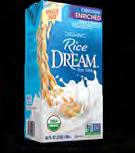
TRY Silk Oatmilk, Chobani


Oat Zero Sugar Vanilla
TRY A CREAMER .
CHOBANI OAT
Coffee Creamer Vanilla
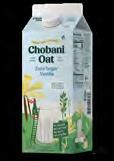
Pea milk is another plant milk high in protein. Made from yellow peas milled into flour—the protein is separated from the fiber and starch, which gives the milk its white color—one cup packs 8 grams of protein, the same as one cup of cow’s milk. The protein also gives this milk a creamy texture with a mild taste. Pea milk contains branched-chain amino acids, which may support muscle growth and regulate blood sugar. Pea protein is naturally gluten- and dairy-free and does not contain any of the top food allergens: peanuts, tree nuts, lactose, wheat and soy. Therefore, it works with nearly any diet.
1 cup contains: 90 calories; 8 g protein; 4.5 g fat; 6 g carbohydrates
Other nutrients: iron
TRY Ripple

Silk NextMilk is made with a blend of oat, coconut and soy milks, plus added nutrients, which mimics the richness and creaminess of dairy milk—without the lactose and fewer calories.

1 CUP CONTAINS: 110 calories; 4 g protein; 8 g fat; 7 g carbohydrates
Made from the grated meat of coconuts, coconut milk is an important element of Asian cuisine. But there is a difference between canned and in a carton. While canned coconut milk has a high fat content and is used for curries and other dishes, coconut milk in a carton is more diluted with water and sometimes also enriched with vitamins. It’s naturally sweet and has about half as many calories as whole milk but has little protein and 5 grams of saturated fat per cup—about the same amount as whole cow’s milk. Numerous studies show that the lauric acid in coconut milk can help lower cholesterol levels and support cardiovascular health.
1 cup unsweetened contains: 60 calories; >1 g protein; 5 g fat;

1 g carbohydrates
Other nutrients: lauric acid (a healthy fatty acid)
TRY Simple Truth Unsweetened

Coconut Milk
DID YO U KNOW?
1 cup of whole cow’s milk contains:
150 CALORIES
8 G PROTEIN
8 G FAT
12 G
CARBOHYDRATES
What makes this type of milk different? It’s basically “regular” cow’s milk that is passed under pressure through a thin membrane. This separates, or filters, the water and lactose (sugar) from the other components of the milk. The result is a lactose-free milk with nearly twice the protein and half the sugar of regular milk, with a rich and creamy texture. This makes ultra-filtered milk appealing to a range of people, including fitness types who like the extra protein, people who are lactose intolerant, and those who need to limit their sugar intake, such as diabetics.


A1 and A2 are two proteins in cow’s milk that are almost identical—each contains 209 amino acids, the building blocks of any protein. The only difference between them is in the 67th amino acid in the chain, where each protein has a different amino acid, so when the A1 protein is broken down, it can create a peptide called BCM-7, which is related to the opiate family and may create negative health effects in humans. Enter a2 Milk, an antibiotic-free, certified kosher dairy milk from local U.S. farms that comes from cows that naturally produce only the A2 protein and no A1. A few studies reveal that a2 Milk can be an alternative for people who experience gut discomfort after drinking milk, but further research is needed.
Aseptic packaging is a specialized manufacturing process in which food, like milk, is sterilized separately from packaging. The contents are then inserted into the container in a sterile environment. This method uses extremely high temperatures to maintain the freshness of the milk while also ensuring that it’s not contaminated with microorganisms. Horizon Organic offers several of its organic, non-GMO milks, most recently adding Growing Years for kids, in aseptic quarts to lock in taste and provide a shelf life of 60 days.
While plant-based milks are getting a lot of attention, innovations in the traditional dairy milk aisle continue.
 BY REBECCA HEATON
BY REBECCA HEATON
It’s hard not to love butter. From spreading on toast and fresh corn cobs, to sautéing vegetables and baking in cookies, pies and cakes, this kitchen staple is well-used. But rich, creamy butter doesn’t have to come from cows. There are many worthy plant-based picks that taste and act just like their dairy counterparts—and are also lower in saturated fat and contain no trans fats. For the 36 percent of the U.S. population who are lactose intolerant, these-dairy free spreads are a healthy option, not to mention their lower impact to produce in terms of climate, water and land usage. Here are a few to try.
European-Style Cultured Vegan Butter
Founder Miyoko Schinner transformed age-old butter-making techniques with plant-based ingredients, resulting in a vegan butter that melts, browns, bubbles, bakes and spreads just like animal dairy butter. USDAcertified organic, non-GMO, and free of lactose, gluten and soy, this award-winning spread is made with plantbased ingredients, including coconut and sunflower oils and cashews.

Well-known for its buttery spreads, Country Crock’s line of plant butters are all dairy-free, gluten-free and certified plant-based by the Plant Based Foods Association. Made with oils from olives, avocados and almonds, these butters have all been verified through testing to mimic the way dairy butter behaves at different temperatures when spreading, cooking and baking.

Plant-Based Butter Alternative

Buttery Spread
Going plant-based doesn’t mean you have to go butterless. Kite Hill whips cultured almond milk with a blend of oils, such as sunflower and coconut, and a touch of cocoa butter for richness to create this creamy, European-style spread. Non-GMO, kosher and dairy-, soy- and gluten-free, this artisanal butter swap is suitable for spreading on a baguette or baking into your favorite cake.
Miyoko’s Creamery launched The Vegan Butter Channel on YouTube to showcase how to cook with vegan butter.


“I created our vegan butter because as a chef and cookbook author, butter is the foundation of so much of my cooking and baking, so it was important that any vegan butter I use tastes and performs up to the highest standards,” says company founder, Miyoko Schinner. Youtube.com/c/MiyokosCreamery
One of the original plantbased spreads, Earth Balance’s rich, buttery taste comes from a blend of palm fruit, canola and olive oils, with a touch of pea protein and other natural flavors. Available in several blends, including original, soy-free and USDA-organic whipped, all are non-GMO and vegan. The Original flavor also comes in sticks for ease when measuring to bake or serve on the table.

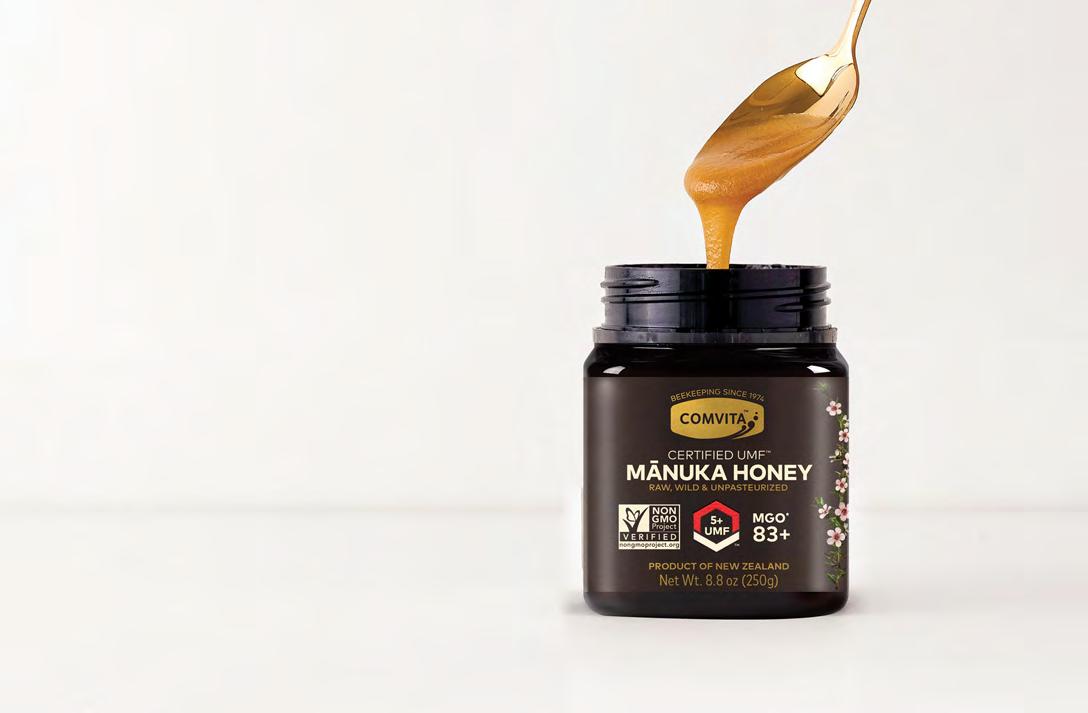



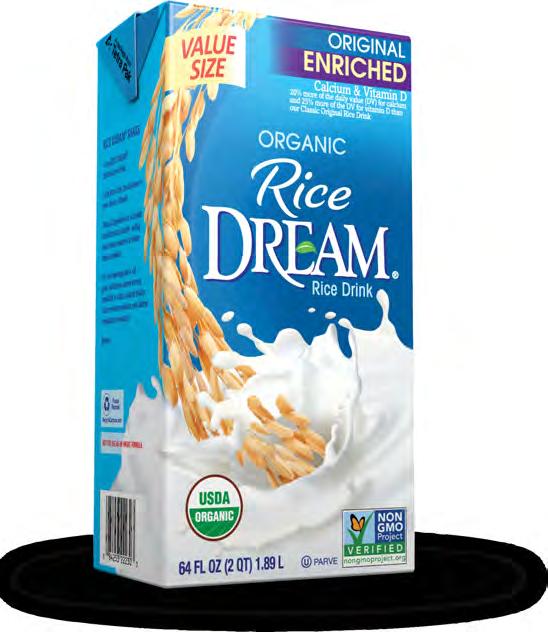
If you love ice cream but are one of the more than 36 percent of the population who are lactose intolerant, or if you are following a more plant-based diet, you have plenty of options! Dairy-free desserts are readily available in the frozen foods aisle. Try some of these creamy and dreamy treats.
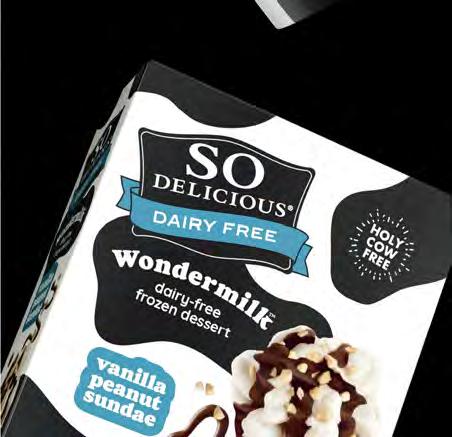
A delicious blend of dairy-free ingredients like smooth oats, crisp soy and creamy coconuts, these frozen treats are dreamy and creamy to satisfy even the most devoted ice-cream-o-philes. All pints and cones are vegan-certified and non-GMO, and pints are also gluten-free.


Pint flavors: Vanilla, Chocolate Cocoa Chip, Cookies & Cream, Buttery Pecan, Strawberry Cone flavors: Salted Caramel Sundae, Vanilla Peanut Sundae

Made from rich and creamy coconut milk, plus a boost of plant protein—10 grams per pint—from fava beans and pea protein, Halo Top’s dairy-free pints are certified vegan and kosher. All pints are just at or under 360 calories for a semi-guilt-free indulgence.
Flavors: Chocolate Almond Crunch, Chocolate Chip Cookie Dough, Peanut Butter Cup, Sea Salt Caramel
One of Kroger’s signature brands, Simple Truth’s treats are free from unhealthy additives and preservatives. Their line of creamy oat milk pints and half gallons are all vegan, non-GMO and lactose- and dairy-free. Several flavors are also available in their Almondmilk Frozen Desserts.

Flavors: Maple Pecan, Sea Salt Caramel, Peanut Butter Chip, Strawberry


Known for their fun, creative and iconic flavors with yummy add-ins, Ben & Jerry’s dairy-free choices are made with almond milk, with some new additions made with sunflower butter. Full of the chunks and swirls of their dairy brethren, these pints are all certified vegan.
Flavors: Change the Whirled, Phish Food, Chocolate Fudge Brownie, Cherry Garcia…and many more!




In her latest cookbook, this Mexican chef and host of a popular PBS series shares a trove of traditional dishes.
BY REBECCA HEATONBorn and raised in Mexico, Pati Jinich loves to cook her native food. “Being from another country fills you with nostalgia and romanticism for your home country,” she says. In her Emmy-nominated series “Pati’s Mexican Table” on PBS, the chef and cookbook author shares the tastes of her childhood intermingled with Mexico’s rich history and culture. She recently premiered a series called “La Frontera” about food and culture in communities along the Texas-Mexican border “where my two beloved countries meet,” she says. And she also found time to work on a new cookbook, Treasures of the Mexican Table (Houghton Mifflin Harcourt, 2021), filled with a wealth of traditional recipes that date back hundreds of years. We caught up with her to learn more.

“When I moved to the U.S. after getting married, I wasn’t a good cook,” laughs Pati. “But I didn’t feel at home, didn’t speak English well and was in between jobs. So, I started to recreate flavors that I knew and loved, having grown up with a family of accomplished cooks and food maniacs. I was able to start growing roots and make a story here because I got so hungry for anything Mexican.” But when she first moved to the U.S., traditional Mexican ingredients were harder to come by. “Now you can find most everything as the appetite for Mexican foods and things in the U.S. has grown tremendously, and people know a lot more about Mexican food and culture and want to bring that into their homes,” she says.
“I really treasure and am very grateful for all that I’ve inherited in terms of Mexican cuisine and culture. I have a deep respect for techniques, stories and classic recipes that have stood the test of time, and I do whatever I can to pass these on,” Pati says of her cooking philosophy. “But I like to leave a door open for new possibilities for those ingredients, too.” She also likes to cook and eat in an unpretentious, unfussy, family-friendly and accessible manner, and to constantly repurpose food that she’s prepared. “Take for example a chicken: You can eat it with rice and beans, and in a few days you can use it in a torta or quesadilla.”
Chipotles in adobo sauce. “I can’t live without them!”
A bowl of avocadoes from Mexico. “In all stages of ripeness.”
Beans. “Black and pinto are a must.”

Rice. “I have fallen in love with jasmine rice. It’s so fragrant and aromatic.”
Tomatoes. “No matter what time of the year, I always have ripe tomatoes.”
Chiles: jalapeno, ancho, guajillo and arbol
Corn tortillas. “Of course!”
3 Cooking Tips
1 It’s important to keep your knives sharpened. It’s very frustrating to prep food for cooking with dull knives.
DID YOU KNOW?
There are
32 states in Mexico, each with a beloved trove of dishes.
2 When you’re cooking a new recipe, take time to read the ingredient list and instructions from start to finish, and make sure you have the ingredients you need. Sometimes you think you have an ingredient, but don’t. If possible, try to prep ingredients ahead, too, which makes cooking a recipe easier.
3 Give yourself the time to cook; it’s very important. To get your food right, you can’t be in a rush. The attitude of cooking should be that you should relax a little. This makes cooking a lot more pleasurable.

MAKES 8 DOUBLE TACOS; SERVES 4 OR 5
2 lbs ripe tomatoes or 1 (28-ounce) can whole tomatoes
4 garlic cloves, peeled
2 to 3 dried chiles de arbol, stemmed
2 tsp dried oregano
2 Tbsp tomato paste
1 tsp kosher salt, plus more for seasoning the shrimp
2 Tbsp vegetable oil, plus more for cooking the tacos
2 lbs medium shrimp, peeled and deveined
Freshly ground black pepper
2 Tbsp unsalted butter
16 corn tortillas
3 cups grated melting cheese, such as asadero, Oaxaca, Monterey Jack, or mozzarella (12 ounces)
1 large ripe avocado, halved, pitted, and thinly sliced
1. Combine the fresh tomatoes, if using, garlic, and chiles de arbol in a medium saucepan, cover with water, and bring to a boil over medium-high heat. Reduce the heat and simmer for about 10 minutes, until the tomatoes, garlic, and chiles are soft. Drain and transfer to a blender.
2. Add the oregano, tomato paste, and salt to the blender, add the canned tomatoes, if using, and puree until smooth.
3. Heat 1 Tbsp of the oil in a medium saucepan over medium heat. Pour in the tomato puree, using the lid to shield yourself from splatters, cover partially, and cook, stirring occasionally, for 5 to 6 minutes, until the mixture has thickened and darkened. Remove from the heat.
4. Season the shrimp with salt and pepper. Heat 1 Tbsp
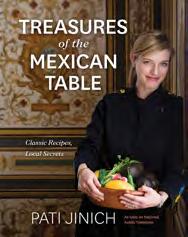

of the butter with 1 Tbsp of the oil in a large skillet over high heat. Once the butter melts and begins to foam, add half the shrimp and sear for a minute or so per side. They should be browned on the outside but just cooked through. Be careful not to overcook, or they will be rubbery. Scrape into a bowl and repeat with the remaining butter, oil, and shrimp.
5. Heat a comal or large skillet over medium heat for at least 5 minutes. Add a tablespoon or two of oil to the surface.
6. Briefly dip a tortilla into the sauce, making sure the entire tortilla is coated (I use a pair of rubber-tipped tongs, but you can just use your hands), and lay on the pan. Dip a second tortilla into the sauce and lay in the pan next to the first one, making sure the tortillas are not overlapping (see note). Top each tortilla with about 2 Tbsp shredded cheese and cook for a couple of minutes, until the cheese begins to melt and the bottoms of the sauced tortillas begin to dry and brown a little. Then, using a spatula, scrape up one tortilla and stack on top of the other one, cheese side up. Don’t worry if the tortilla you scraped up sticks and tears a little bit or if it does not sit evenly on top of the other one. Spoon some
If your pan isn’t large enough to hold two tortillas without overlapping, for each stack, dip and cook one tortilla, topping it with cheese, remove it from the pan, and dip and cook a second tortilla, then stack them together, top with some shrimp, and finish cooking as above.
seared shrimp on top of the stack, gently fold the stack in half, and cook for a couple of minutes longer, turning the stack over occasionally, until the cheese has begun to ooze out and create a crust.
7. Top with slices of ripe avocado and serve (these are best straight out of the comal), or transfer to a plate or platter and cover with foil to keep warm while you cook the remaining stacks.
PER SERVING: 586 CAL; 54 G PROTEIN; 54 G CARB (3 G SUGARS); 2,056 MG SODIUM; 10 G FIBER
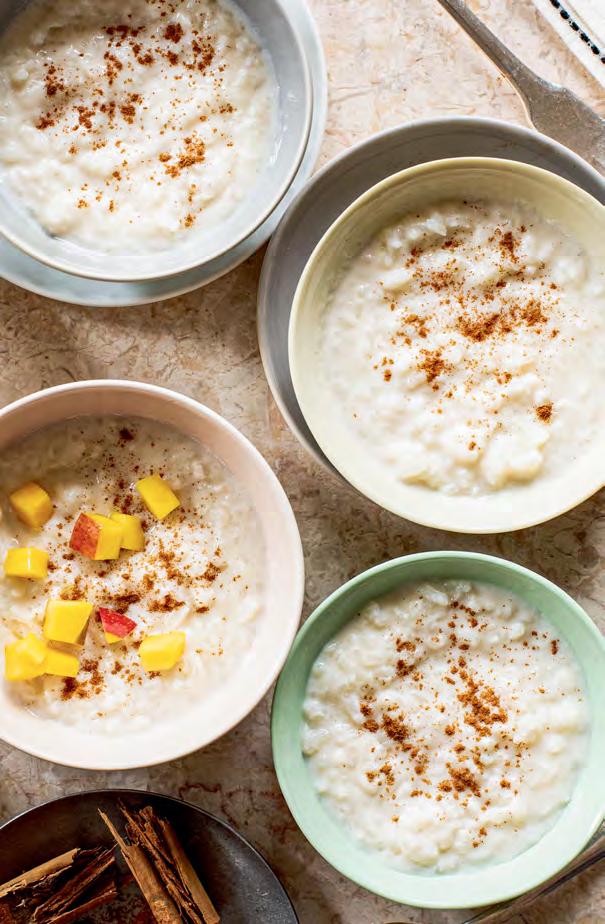
SERVES 6 TO 8
1 cup long-grain white rice or jasmine rice
2 cups water
4 cups whole milk
¾ cup sweetened coconut cream, such as Coco Lopez, thoroughly mixed before measuring (see note)
Rind of half an orange
1 (2-inch) canela or cinnamon stick
1 star anise
3 Tbsp sugar
½ tsp kosher salt
3 to 4 Tbsp dark raisins (optional)
1 tsp vanilla extract
Ground canela or cinnamon
Diced mango or other fresh fruit
Whipped cream
1. Combine rice and water in a medium-heavy saucepan and bring to a boil. Reduce heat to medium and simmer for 3 minutes, stirring and scraping the bottom of the pan so rice
doesn’t stick to it. Add milk, coconut cream, orange rind, canela or cinnamon stick, star anise, sugar, and salt, stirring well to combine. Bring to a simmer, reduce heat to low, and cook at a low simmer, stirring occasionally, until rice is soft, about 20 minutes. Pudding will still be soupy. Stir in the raisins, if using.
2. Remove from heat and stir in vanilla until well-combined. With a slotted spoon or tongs, fish out canela or cinnamon stick, orange rind, and star anise. The rice will absorb more liquid as it cools, but pudding will remain soupy.
3. Serve hot, warm, or chilled. If desired, sprinkle with canela or cinnamon and/or top with fresh fruit and/or whipped cream.
Note: Without the optional toppings, the pudding can be refrigerated, covered, for up to five days.
PER SERVING: 292 CAL; 7 G PROTEIN; 36 G CARB (13 G SUGARS); 230 MG SODIUM; 1 G FIBER
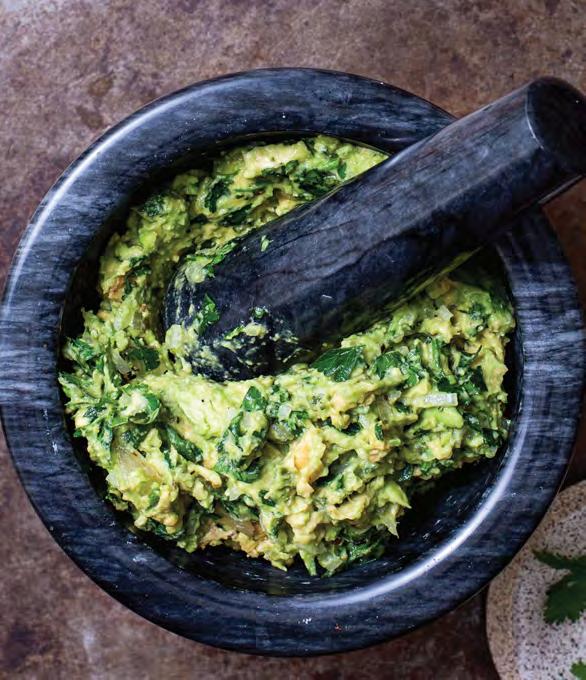
MAKES ABOUT 2 CUPS
1 serrano or jalapeno chile, or more to taste
2 garlic cloves, not peeled
1 (½-inch-thick) slice white onion
1 Tbsp freshly squeezed lime juice
1 tsp kosher salt, or to taste
3 Tbsp coarsely chopped fresh cilantro leaves and upper stems
3 ripe avocados, halved, pitted, and flesh scooped out
1. Preheat the broiler, with the rack 2 to 3 inches from the heat source. Put the chile, garlic cloves, and onion slice on a baking sheet lined with foil and broil for 5 to 8 minutes, turning the vegetables halfway
through, until charred on all sides. Alternatively, you can toast the vegetables on a comal or large skillet over medium heat, turning them every 3 to 4 minutes, until blackened. Remove from the heat.
2. When they are cool enough to handle, peel the garlic cloves and cut the stem from the chile. Coarsely chop the chile, garlic, and onion. Place in a molcajete or bowl, add the lime juice and salt, and mash and mix with a pestle, fork, or wooden spoon until pasty. Add the cilantro and avocados and mash together until the mixture has reached the desired consistency (some people prefer a chunkier guacamole, others like it smooth). Taste for salt and serve.
PER CUP: 499 CAL; 7 G PROTEIN; 30 G CARB (3 G SUGARS); 1,186 MG SODIUM; 21 G FIBER
NUTRITIONAL VALUES CALCULATED AT HAPPYFORKS.COM/ANALYZER
Coconut cream tends to separate in the can, so be sure it’s mixed well before you measure the cream. Shaking the can is not always sufficient: If it doesn’t look well-mixed, pour all the cream out into a bowl, whisk well, and then measure.
THIS POPULAR DESSERT IS immortalized in a favorite Mexican children's song.Some versions of guacamole ahumado are made with just roasted chiles and salt.
Healthy meals to whip up in a wok

noodle swap
Almost any thin noodle will work well, like spaghetti and Bolognese.
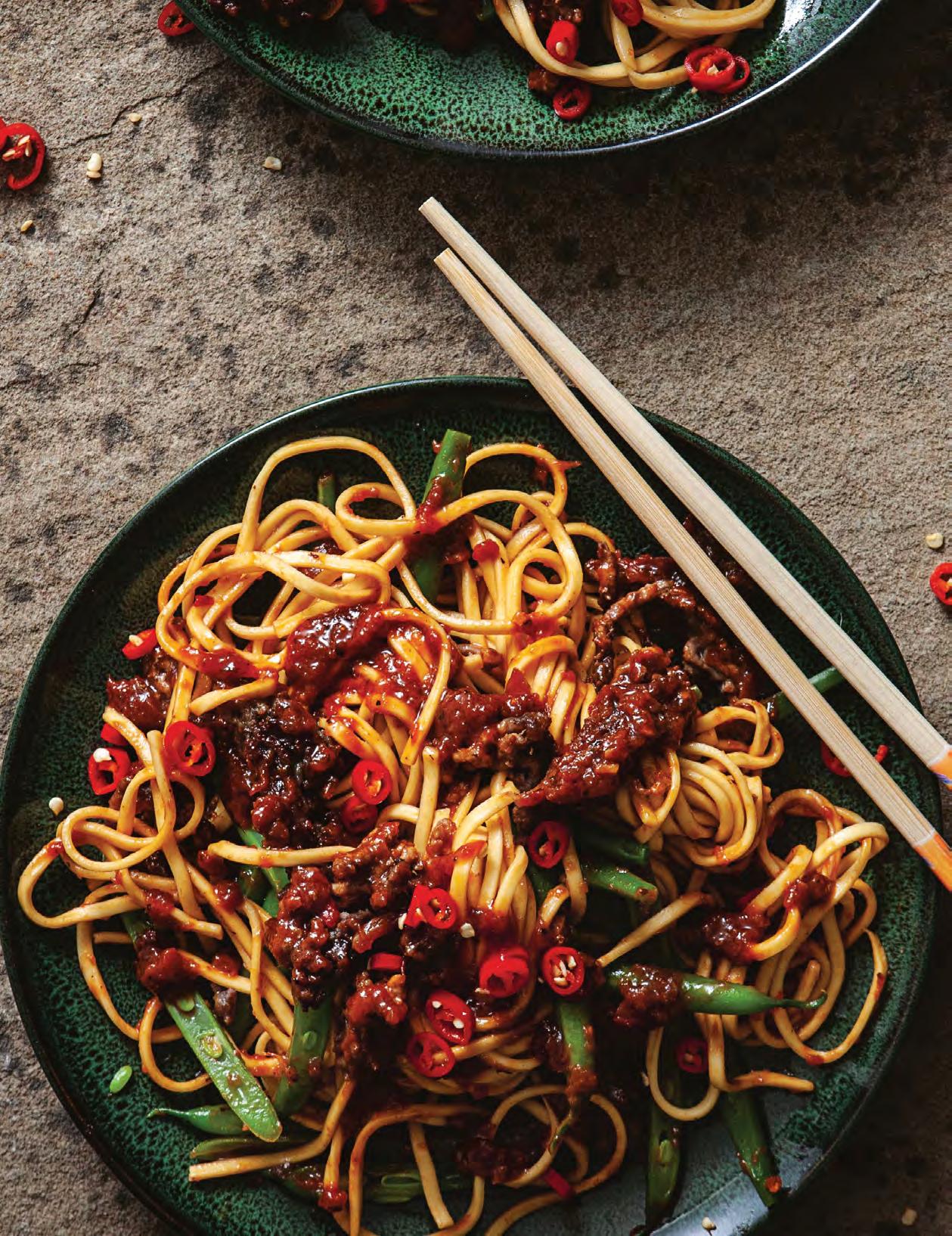
This is an addictive umami overload—it’s quite simply impossible to have leftovers
SERVES 4
2 onions, 1 roughly chopped and 1 thinly sliced ½ cup black bean sauce
3¼ Tbsp Chinese chili or chili-garlic sauce
2 fat garlic cloves
3 Tbsp tomato puree
14 oz beef minced 1 cup green beans, trimmed 14 oz fresh or straight-towok medium egg noodles
1 Tbsp dark soy sauce
1. Make a sauce by putting chopped onion into a food processor with the black bean sauce, chili sauce, garlic and tomato puree. Add 1 cup water and whizz to a fairly smooth sauce.
2. Fry beef in ½ Tbsp oil in your largest frying pan, breaking up lumps with a wooden spoon as it browns. Tip the browned beef out onto a plate, and add sliced onion with another ½ Tbsp oil and a splash of water. Lower heat slightly, and fry onion until softened, scraping up any stuck beefy bits as you go. Return beef to the pan, then stir in the sauce with another cup water. Bring to a simmer and cook 15 minutes, stirring occasionally and scraping the bottom to stop it catching.
3. Cook green beans for 4 minutes in boiling water until tender, then drain. Carefully stir beans, noodles and soy sauce through the beef mixture (if pan is too full, you can heat the noodles following the packet instructions then serve beef on top). When noodles are evenly mixed through and hot, serve.
PER SERVING: 684 CAL; 44 G PROTEIN; 17 G FAT; 86 G CARB (7 G SUGARS); 760 MG SODIUM; 7 G FIBER
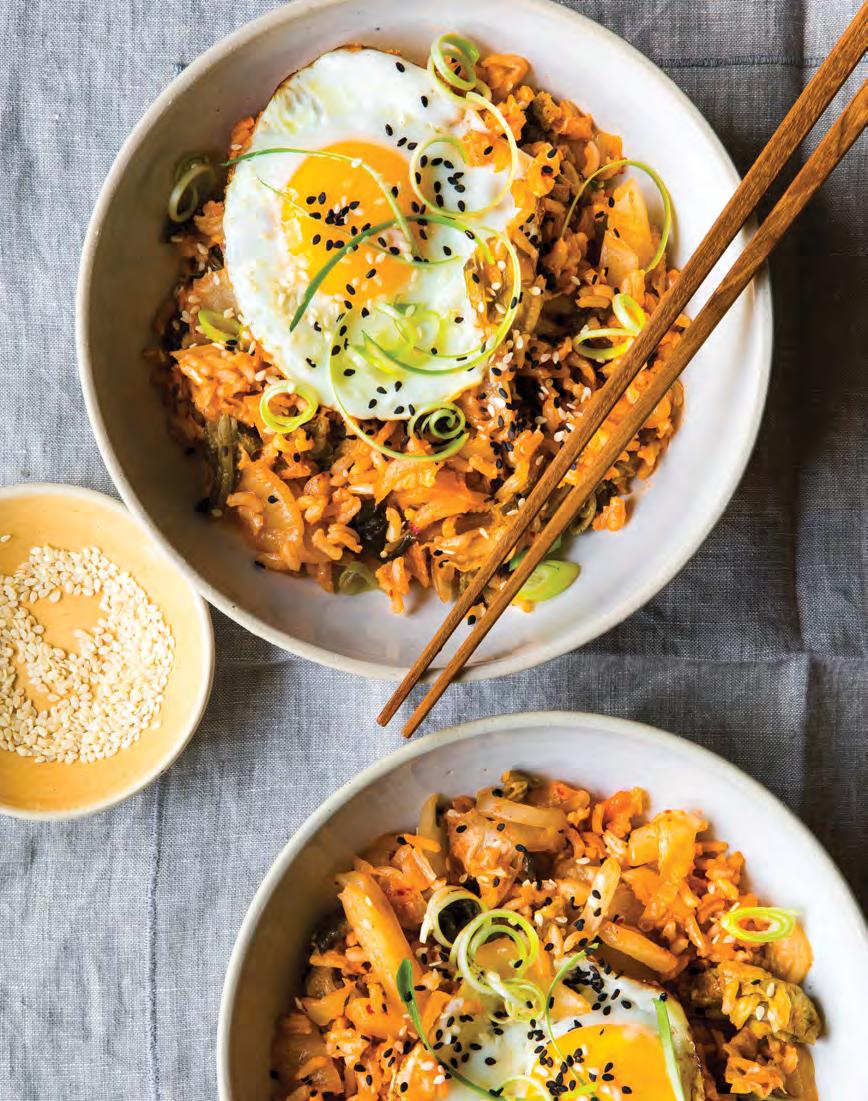 BY CHRIS
BY CHRIS
2 Tbsp Shaoxing rice wine
6 saffron threads
2 Tbsp cooking oil
2 garlic cloves, crushed and chopped
1 Tbsp crushed and chopped peeled ginger
4 oz mushrooms, sliced
1 medium onion, diced into ½-inch pieces
½ tsp salt
½ tsp black or white pepper
2 cups day-old cooked rice
1 Tbsp soy sauce
1 Tbsp sesame seeds
4 scallions, green and white parts, cut diagonally into ¼-inch pieces
4 large fried eggs with soft yolks

1. Pour wine into a small bowl, glass or jar.
2. Crumble saffron into the wine and let soak.
3. In a wok, heat cooking oil over high heat until it begins to smoke.
4. Add garlic, ginger and mushrooms. Stirfry for 2 minutes.
5. Add onion, salt and black pepper. Stir-fry for 1 minute.
6. Add rice, soy
sauce, saffron with wine, sesame seeds and scallions. Stir-fry for 1 minute, or until all ingredients are well-combined.
7. Divide stir-fry into 4 bowls and top each with a fried egg. Serve immediately. PER
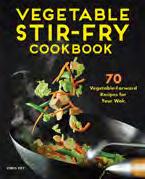
This recipe is inspired by the popular Thai street food dish pad kee mao, or “drunken noodles.”

SERVES 2 OR 3
8 cups plus ¾ cup water, plus more as needed
8 oz rice noodles, as thick as you can find
2 Tbsp oyster sauce
2 Tbsp soy sauce
1½ Tbsp fish sauce
1½ Tbsp sriracha, or to taste
1 Tbsp dark brown sugar
Aromatic, packed with flecks of kale and punctuated with fresh vegetables, every component of this fried rice delivers SERVES 2 OR 3
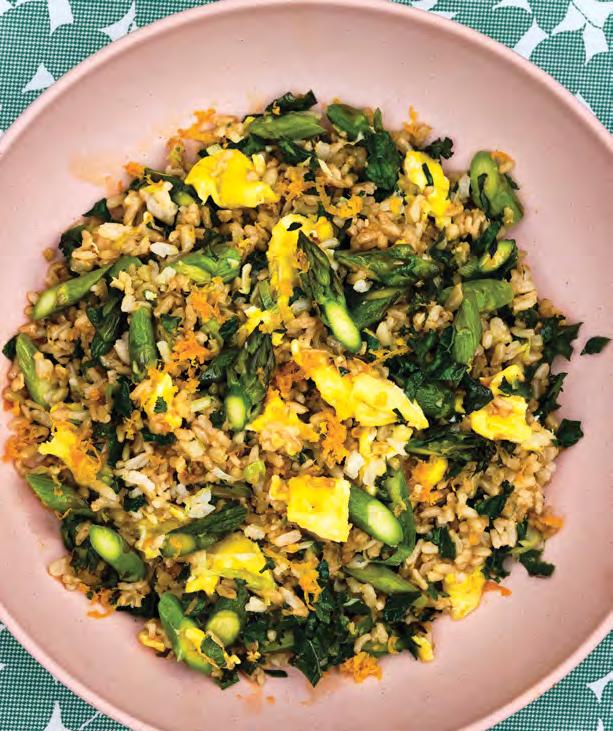
1½ Tbsp toasted sesame oil
4 green onions, white and green parts, chopped
1 cup sliced asparagus or green beans, trimmed and cut into ¼-inch segments
2 cloves garlic, minced
1 Tbsp peeled and grated fresh ginger
2½ cups cold cooked brown rice
2 cups wellchopped kale, trimmed and ribs removed
2 eggs, beaten
2 to 3 tsp tamari or soy sauce
Chilesesame oil and zest of 1 lemon, to serve (optional)

1. Heat 1 Tbsp of the sesame oil in a large skillet or wok over high heat. Add green onions and asparagus and cook for 3 to 4 minutes, until green onions soften.
2. Stir in garlic and ginger. Wait 30 seconds, then add rice and stir to separate the grains. Cook for about 3 minutes, until rice is hot, then stir in kale.
3. Shift rice and vegetables to the sides of the skillet and add remaining ½ Tbsp sesame oil to the pan. Add eggs and push them around until just set. Break up eggs with a spatula.
4. Drizzle in tamari and stir-fry everything together until well-combined, about 30 seconds.
5. To serve, drizzle with chile-sesame oil if you like a bit of heat and sprinkle with lemon zest. Serve immediately.
PER SERVING: 309 CAL; 10 G PROTEIN; 11 G FAT; 42 G CARB (3 G SUGARS); 393 MG SODIUM; 5 G FIBER
BY HEIDI SWANSON.
3 large eggs
Salt
5 Tbsp vegetable oil
1 lb large shrimp, peeled and deveined
2½ cups bite-sized broccoli florets
1 bunch of scallions (light & dark green parts separated), thinly sliced
1. Soak noodles: Bring 8 cups water to a boil in a large pot. Remove pot from heat and add rice noodles. Stir well so they don’t stick, then let soak, stirring frequently, until soft and al dente. Drain and rinse well with cold water. (If not using the noodles right away, toss them with a little oil to prevent sticking.)
2. In a medium bowl, whisk together oyster sauce, soy sauce, fish sauce, sriracha, brown sugar and ¼ cup of the water.
3. In small bowl, beat eggs with 1/8 tsp salt.
4. Heat 1 Tbsp of oil in a large (12-inch) nonstick skillet or wok over medium-high heat until shimmering. Add shrimp and sprinkle with 1 /8 tsp salt; cook, tossing occasionally, until shrimp are opaque and just cooked through, about 2 mins. Transfer shrimp to large bowl.
5. Add 1 Tbsp of oil to skillet; add eggs and scramble until cooked through. Transfer eggs to bowl with shrimp.
6. Add broccoli to pan along with 1 /8 tsp salt and remaining ½ cup water. Cover and steam until cooked through, about 2 mins. Transfer broccoli to bowl with shrimp and eggs. Discard excess water from pan and wipe it clean.
7. Return pan to stove, increase heat to high, and
4 garlic cloves, minced
½ cup loosely packed Thai or Italian basil leaves, roughly chopped
1 Tbsp fresh lime juice (from 1 lime)
Lime wedges, for serving (optional)
add remaining 3 Tbsp oil. When oil is shimmering, add light scallions and garlic and cook, stirring constantly, until fragrant, about 1 min.
8. Add noodles and sauce and toss until noodles absorb sauce and are tender, 3 to 5 mins. If noodles remain a bit tough, add 2 Tbsp water and continue to toss and cook until tender.
9. Add shrimp, eggs, broccoli, dark scallions, basil and lime juice, and toss until heated through. Taste and adjust seasoning if necessary. Serve immediately with lime wedges, if desired.
PER SERVING: 493 CAL; 31 G PROTEIN; 29 G FAT; 25 G CARB (1 G SUGARS); 2,342 MG SODIUM; 2 G FIBER
ADAPTED FROM ONCE UPON A CHEF WEEKNIGHT/WEEKEND © 2021 BY JENNIFER SEGAL. REPRODUCED BY PERMISSION OF CLARKSON POTTER. ALL RIGHTS RESERVED.

Oyster sauce is a thick, dark brown condiment made primarily from oyster extracts. Despite its name, oyster sauce doesn’t taste strongly of oysters; rather, it has a salty, savory, slightly sweet flavor. You can find it in the Asian section of most supermarkets.

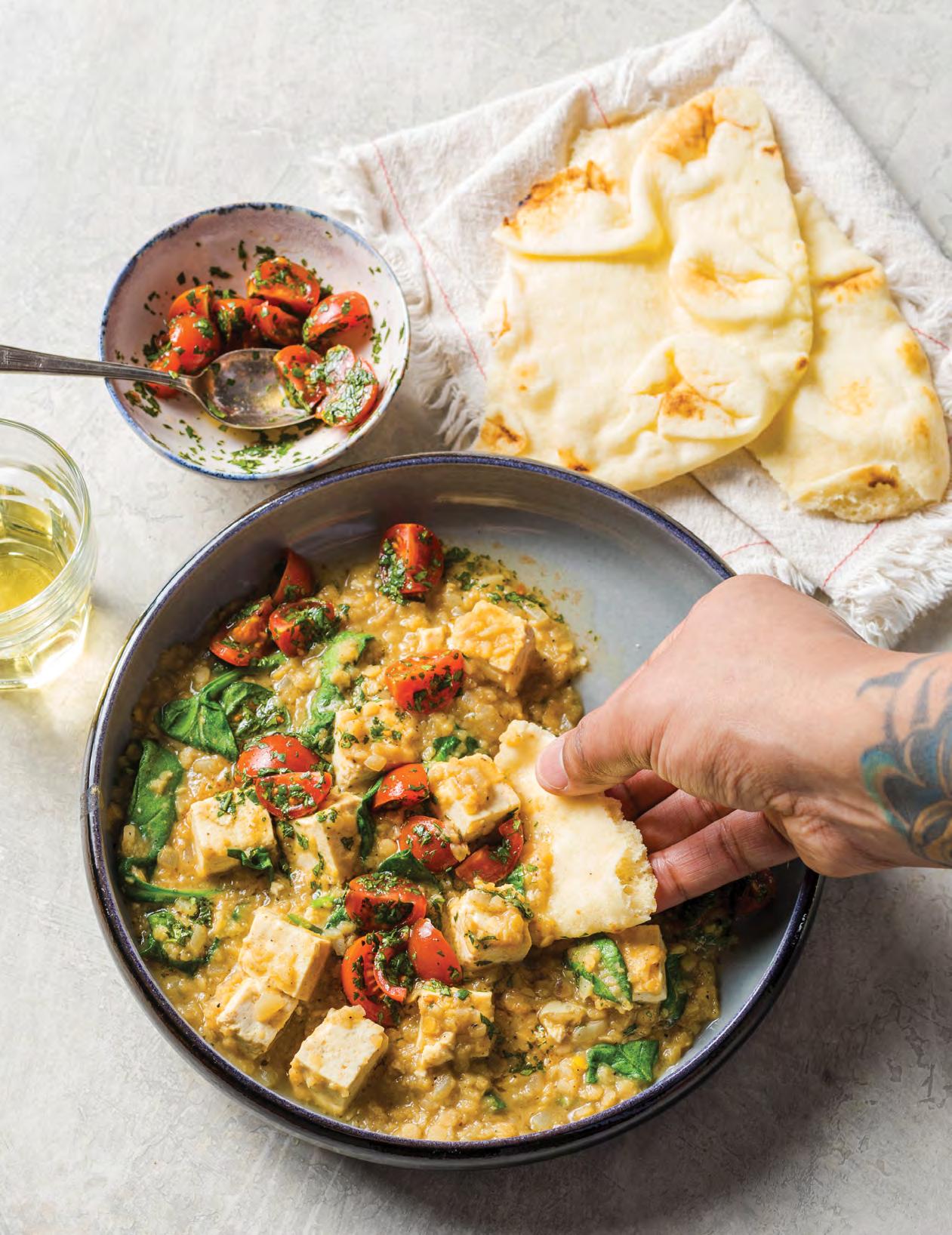
make it heartier
Add roasted vegetables like cauliflower, potatoes and/or squash.

2 Tbsp oil, divided
1 small onion, chopped fine
2 garlic cloves, minced
1¼ tsp garam masala
1 tsp grated fresh ginger or 1 ⁄8 tsp ground ginger
Pinch cayenne pepper
2 cups chicken or vegetable broth
½ cup red lentils, picked over and rinsed
3 ounces cherry or grape tomatoes, quartered (½ cup)
2 Tbsp minced fresh cilantro or parsley
1 tsp lime juice
7 oz firm tofu, cut into ¾-inch pieces
1 cup baby spinach
1. Heat 1 Tbsp oil in medium saucepan over medium heat until shimmering. Add onion and cook until softened, about 5 minutes. Stir in garlic, garam masala, ginger and cayenne and cook until fragrant, about 30 seconds. Stir in broth and lentils, bring to a simmer, and cook over low heat until lentils are tender and resemble thick, coarse puree, 12 to 15 minutes. Season with salt and pepper to taste.
2. Meanwhile, combine tomatoes, cilantro, lime juice, and remaining 1 Tbsp oil in bowl. Season with salt and pepper to taste; set aside until ready to serve.
3. Stir tofu and spinach into lentils and cook until spinach is wilted and tofu is warmed through, 2 to 3 minutes. Top dal with tomato mixture. (Dal and tomato mixture can be refrigerated separately for up to 2 days.)
PER SERVING: 958 CAL; 57 G PROTEIN; 47 G FAT; 89 G CARB (10 G SUGARS);
1,948 MG SODIUM; 18 G FIBER
EXCERPTED FROM COOKING FOR ONE © 2020 BY AMERICA’S TEST KITCHEN. PUBLISHED BY AMERICA’S TEST KITCHEN. ALL RIGHTS RESERVED..
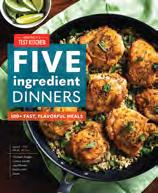
2 scallions, sliced thin
1½ cups kimchi, drained, squeezed dry and chopped
6 large eggs
2 Tbsp chopped fresh cilantro

1. Adjust oven rack to middle position and heat oven to 450º. Spray rimmed baking sheet with vegetable oil spray. Shred potatoes with food processor or box grater then transfer to large bowl. Cover with cold water and let sit for 5 minutes. Drain potatoes in a colander and rinse and dry bowl. Using clean dish towel, squeeze potatoes dry in four batches, transferring dried potatoes to dry, now-empty bowl.
2. Add scallions, ¼ cup vegetable oil, 1 tsp salt, and ½ tsp pepper to potatoes and toss to combine. Distribute potatoes in even layer on sheet, but do not pack down. Bake until top of potatoes is spotty brown, 32 to 35 minutes.
3. Remove sheet from oven. Using metal spatula, flip hash browns
Kimchi kicks up the flavor of this easy sheet-pan recipe.

SERVES 4 TO 6
in sections, then sprinkle kimchi evenly over top. Using back of spoon, create six 3-inch-wide indentations in potatoes. Crack 1 egg into each and sprinkle with ¼ tsp salt and ¼ tsp pepper.
4. Bake, rotating sheet halfway through, until whites are just beginning to set but still have some movement when sheet is shaken, 7 to 8 minutes for slightly runny yolks or 9 to 10 minutes for soft-cooked yolks. Season with salt and pepper to taste and sprinkle with cilantro. Serve.
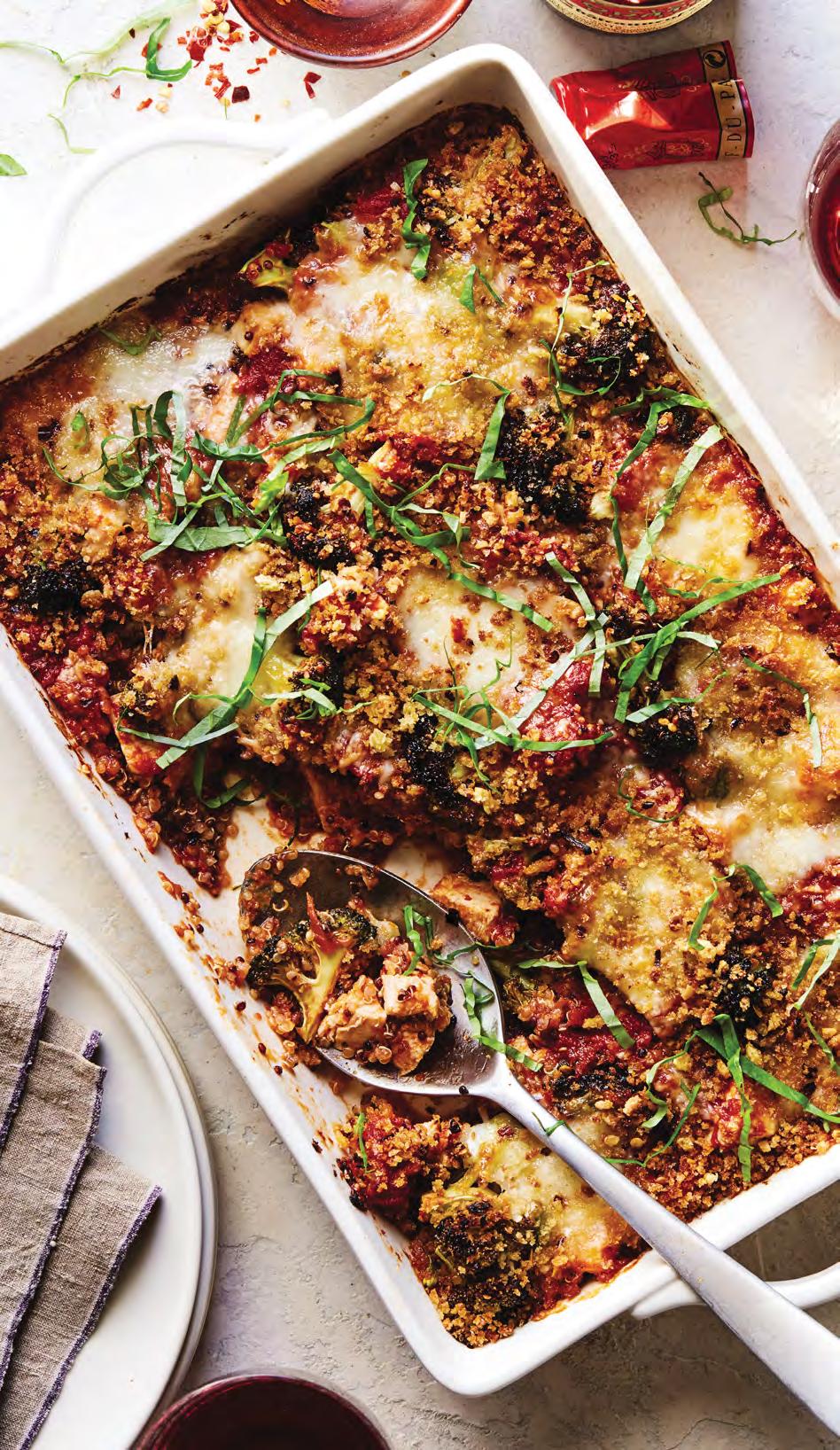 BY SERENA WOLF
BY SERENA WOLF
¾ cup quinoa, rinsed and drained
1¼ cups low-sodium chicken broth
4 cups broccoli florets
2 Tbsp extra-virgin olive oil
Kosher salt to taste
Freshly ground black pepper to taste
3 garlic cloves, minced 1⁄3 cup whole-wheat panko bread crumbs
¼ tsp crushed red pepper flakes (optional)
One 8-ounce ball fresh mozzarella, divided 2 cups diced or shredded chicken breast (or store-bought rotisserie bird)
2½ cups marinara sauce, divided ¼ cup freshly grated Parmesan cheese
Chopped fresh basil for serving (optional)
1. Preheat oven to 425º.
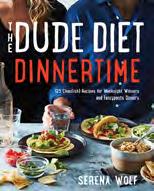
2. Combine quinoa and chicken broth in a small saucepan and bring to a boil. Lower to a simmer, cover the saucepan with a lid, and cook for 14 minutes, or until all of the liquid has been absorbed. Let quinoa rest, covered, for 5 minutes, then fluff with a fork.
3. Place broccoli in a large (12-inch) ovenproof skillet. Drizzle with 1 Tbsp of oil and sprinkle with a pinch of salt and a few cranks of black pepper. Toss to coat. Arrange broccoli in a single layer in the skillet. Transfer to oven and roast for 13 to 15 minutes, until tender and lightly browned in spots. When you take broccoli out of the oven, reduce temperature to 375°.
To make grating and slicing fresh mozzarella a breeze, pop the ball into the freezer for 15 minutes beforehand to firm up the cheese.
4. While broccoli is roasting, heat remaining 1 Tbsp oil in a small skillet over medium heat. When oil is hot and shimmering, add garlic and cook for about 2 minutes, until golden brown. (Be careful not to burn garlic! If it looks like it’s browning too quickly, turn down heat.) Stir in bread crumbs and red pepper flakes (if using) and cook for 2 to 3 minutes, until crumbs are nicely toasted and have darkened a shade in color. Transfer bread crumbs to a small bowl.
5. Grate half mozzarella ball on large holes of a box grater. Slice remaining half into very thin rounds. (The rounds don’t need to be perfect—they’re going to melt!)
6. Add chicken, cooked quinoa, 2 cups of marinara sauce, and grated mozzarella to the skillet with broccoli. (Be careful, the skillet is HOT!) Fold everything together with a spatula until well-combined. Taste and season with a little salt and pepper if necessary. Smooth top of the filling with a spatula. Spread remaining ½ cup marinara sauce on top, then add sliced mozzarella cheese and sprinkle with Parmesan cheese and garlicky bread crumbs. Bake for 20 to 25 minutes, until the cheese has melted and topping is lightly browned.
7. Let rest for 10 minutes. (Trust me, you will burn your tongue!)
Serve warm, topped with fresh basil, if you like.
PER SERVING: 860 CAL; 84 G
PROTEIN; 30 G FAT; 63 G CARB (13 G SUGARS); 1,394 MG SODIUM; 9 G FIBER
EXCERPTED FROM THE DUDE DIET DINNERTIME © 2019 BY SERENA WOLF. REPRINTED COURTESY OF HARPER WAVE, AN IMPRINT OF HARPERCOLLINS PUBLISHERS. ALL RIGHTS RESERVED.
Who knew that you could roast, instead of boil, gnocchi?
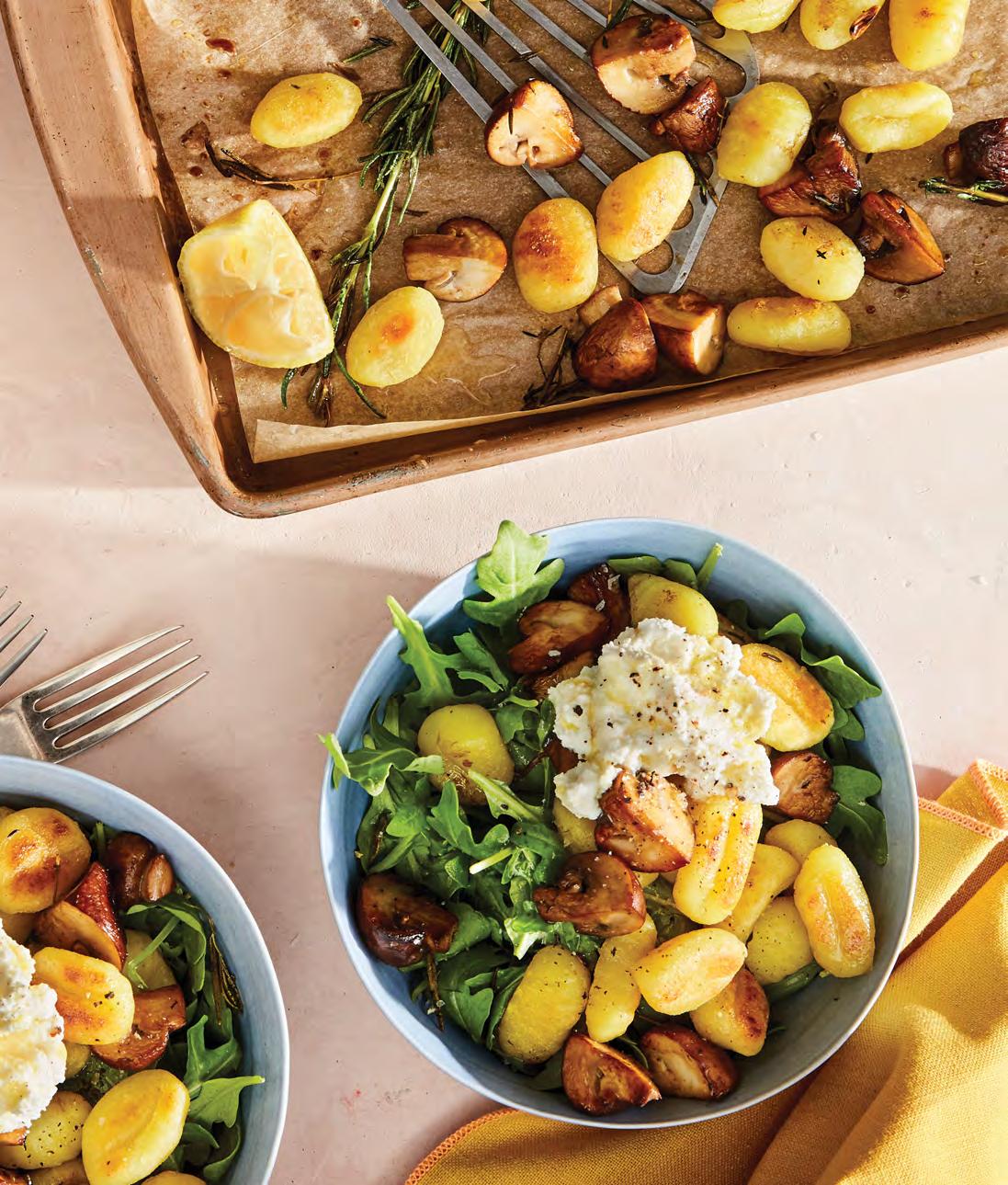
SERVES 4
1 lb refrigerated or shelf-stable gnocchi (such as De Cecco)
10 oz button or cremini mushrooms, trimmed and quartered
3-5 sprigs woodsy herbs (such as rosemary, oregano, thyme, or sage; optional)
2 Tbsp olive oil, plus more for drizzling
½ tsp kosher salt
6 cups baby arugula
½ cup full-fat ricotta cheese
½ lemon

1. Preheat oven to 425°. Line a rimmed baking sheet with parchment paper.
2. Combine gnocchi, mushrooms and herbs, if using, on prepared baking sheet. Add olive oil and salt and toss to coat, then spread out gnocchi and mushrooms in a single layer. Roast until gnocchi are
tender and mushrooms are golden, about 20 minutes.
3. Divide arugula into 4 shallow bowls or plates. Top with the gnocchi mixture, and then dollop with ricotta. Squeeze lemon over the plates, drizzle with more olive oil and serve.
PER SERVING: 278 CAL; 9 G PROTEIN; 16 G FAT; 25 G CARB; 661 MG SODIUM; 2 G FIBER
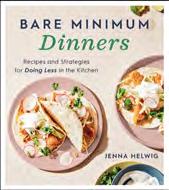
EXCERPTED
BY
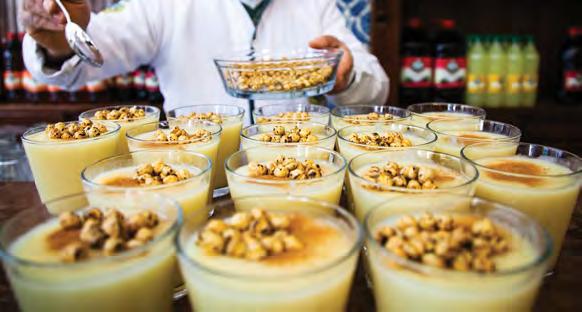
 BY REBECCA TREON
BY REBECCA TREON
In ancient times, Turkey was the intersection of Asia and Europe, a crossroads of trade that pollinated the region with different cultures and cuisines. Once known as Anatolia, Turkey’s rich history spans across centuries ruled by the Persians, Romans and Ottomans, finally becoming an independent republic in 1923. Its geography is diverse—with rugged mountains in the east, fertile valleys in the west, semiarid deserts in the southwest, and temperate zones along the Black Sea coast to the north and the Mediterranean Sea to the southeast—and the country’s cuisine reflects this variety. But the one constant for Turks throughout history has been sharing a meal with family or friends, a bedrock of the culture.
According to Robyn Eckhardt, author of Istanbul & Beyond: Exploring the Diverse Cuisines of Turkey (Mariner, 2021), you won’t see Turks eating fast food behind the wheel while driving. “I’ve seen truck drivers stop in the median of a highway, set up a portable barbecue grill and have a picnic lunch right there,” she says. “Stopping for the ritual of eating and eating together is very important, because food, gathering together and eating communally is a big focus—enjoying food is how you welcome guests and how you spend time together.”
While Turkish food appears meatheavy, particularly focusing on lamb, Eckhardt says that’s not the case. In fact, the cuisine is very regional and, in many areas, people opt for beef, seafood, or vegetables and legumes at the heart of a meal. “Before researching my book, I assumed that Turkish food was kebabs, small plates called meze, chopped salads and baklava—the things you see in Turkish restaurants in America,” Eckhardt says. “I discovered that is a fraction of
Turkey’s dishes. The food is really very regional.”
Eckhardt describes Turkish food as hyperlocal and ultra-fresh, with many dishes prominently featuring olive oil, whether using it for frying or drizzled on top. A meal will always include at least two side dishes of vegetables (cooked or fresh) or legumes, plus yogurt as a topping or dip, sometimes with savory herbs or spices added, to add heft to a meal. Legumes (like garbanzos, lentils or white beans) or vegetables cooked in a tomato sauce, stuffed vegetables like eggplant, and vegetables and meat layered and baked in clay pots (called güveç) are typical dishes throughout the country. Tost, or grilled cheese, is also a familiar dish. Many types of vegetables are pickled and served as a side dish, and artisan products are commonly found at the markets frequently visited throughout the country. Preparations for dishes are simple because they rely on the flavor of the ingredients to come through.
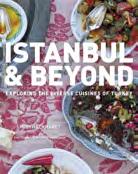
“Turkish people are passionate about freshness and getting the best ingredients from the market, and not doing too much to change them,” says Eckhardt. “Markets are
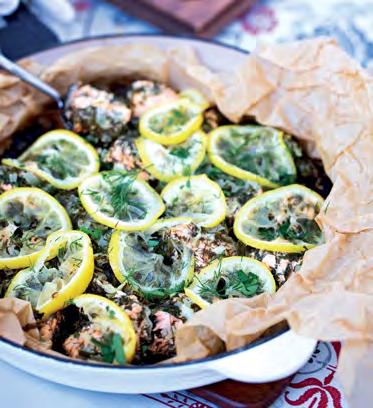
everywhere, and going to the market is a part of daily life.”
Because eating is a shared experience, family and friends will gather and enjoy small dishes, ordering a few at a time, eating and drinking over several hours at cafes called meyhane Ordering meze, the small, shareable plates, will be accompanied by beer or wine, and finish with a grilled or fried fish. At home, cooks will make sourdough loaves or flatbread and serve them with spicy dips. They’ll roast a whole chicken with caramelized onions or serve vegetables stuffed with bulgur. Stews may have a broth infused with yogurt, and meatballs are nestled in a tomato sauce with seared eggplant and thyme. Spices, especially crushed red pepper and Aleppo pepper, are common enough to be found on restaurant tabletops, and warmer spices that once traveled the Silk Road— like cinnamon, ginger, allspice and even curry— are also used.
RECIPE ADAPTED FROM ISTANBUL & BEYOND © 2021
BY ROBYN ECKHARDT. PUBLISHED BY MARINER BOOKS,Regardless of the Turkish dishes you choose to try, gather with those you love to enjoy them the traditional Turkish way—eaten in the company of friends and family, savoring not only the flavors of the food, but also of community.

1 pound skin-on salmon, mackerel, bluefish or other oily fish, or whole fresh sardines or anchovies, cleaned and cut into 1½- to 2-inch pieces
1 medium onion, finely chopped
6 garlic cloves, thinly sliced
1⁄3 packed cup chopped fresh dill
DIRECTIONS

1. Cut a 2-foot length of parchment paper and center it in a 10-inch skillet that has a lid.
1⁄3 packed cup chopped fresh flat-leaf parsley
¾ tsp fine sea salt
½ tsp freshly ground black pepper
¼ cup olive oil
2 lemons, sliced as thin as possible
2 Tbsp dry white wine or water
2. Put the fish, onion, garlic, herbs, salt and pepper in a medium bowl, drizzle over 2 Tbsp of the olive oil, and gently toss. Transfer to the lined skillet.
3. Arrange lemon slices in a single layer over the fish. Drizzle the remaining 2 Tbsp olive oil and the wine or water over. Fold the paper over to cover the fish and crimp edges together to seal, then cover the pan. Cook over medium-high heat for 5 minutes; do not uncover the pan. Reduce the heat to medium and continue to cook, covered, for another 10 to 15 minutes, depending on how wellcooked you like your fish. Remove the pan from heat and rest for 5 minutes.
4. Remove the lid, carefully open the paper, and serve directly from the skillet, so diners can use bread to mop up the juices.
PER SERVING: 588 CAL; 49 G PROTEIN; 37 G FAT; 14 G CARB (4 G SUGARS); 1,068 MG SODIUM; 3 G FIBER NUTRITIONAL VALUES CALCULATED AT HAPPYFORKS.COM/ANALYZER
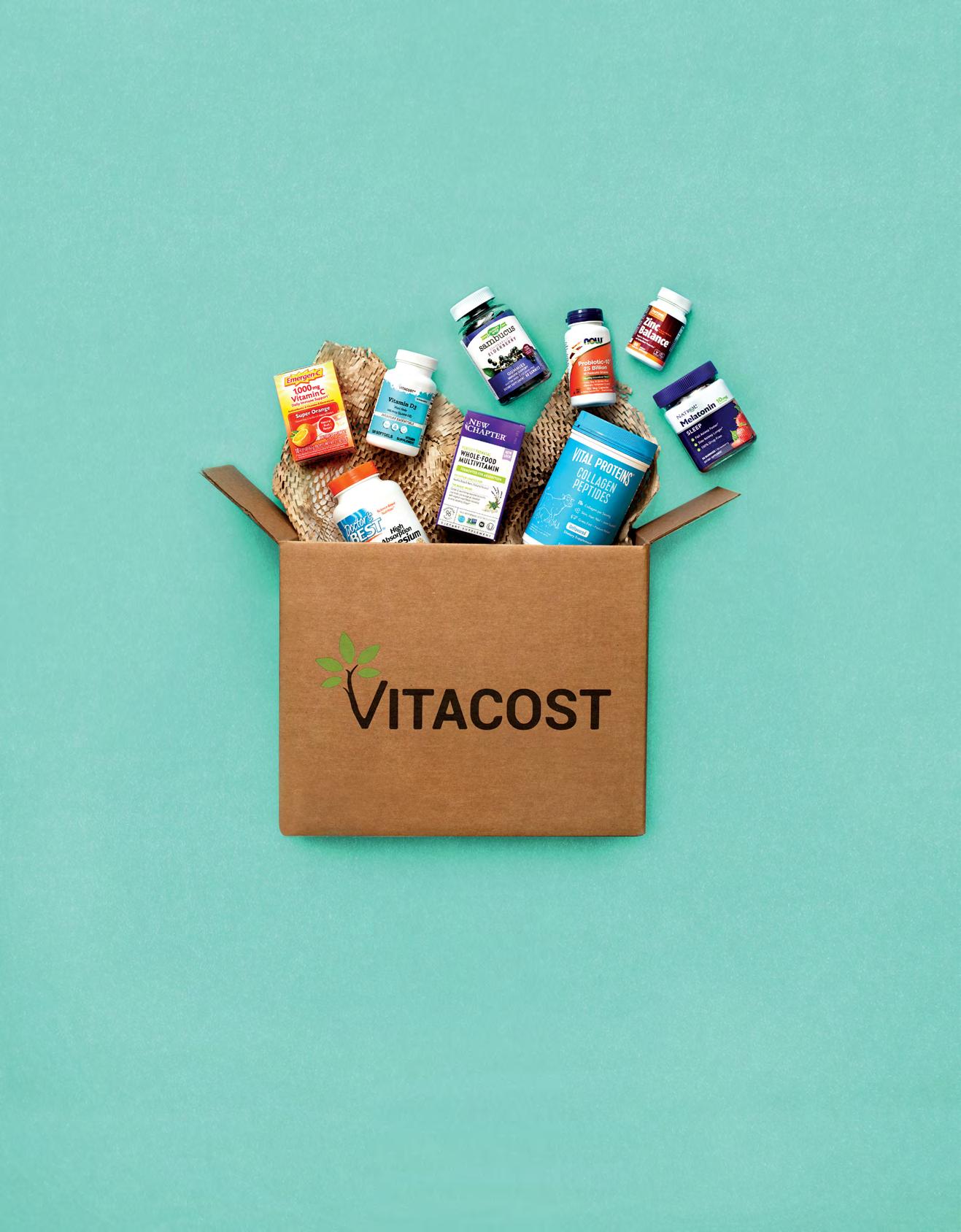
INFLAMMATION & IMMUNITY
Natural ways to keep these in balance

HAPPY HEART Supplements to support heart health

HORMONAL HEALTH
Herbs and minerals to promote sexual well-being
From a simple seed planted in the ground with a little water, nutrients from the soil, and a whole lot of energy from the sun, comes the wholesome nutrition that sustains our lives.


wholeearthsea.com

Factors Farms are certified 100% organic. Our crops are fertilized with compost and nitrogenrich sea plants, and are meticulously cared for by hand.


This is the vision that created the greatest multivitamins ever.
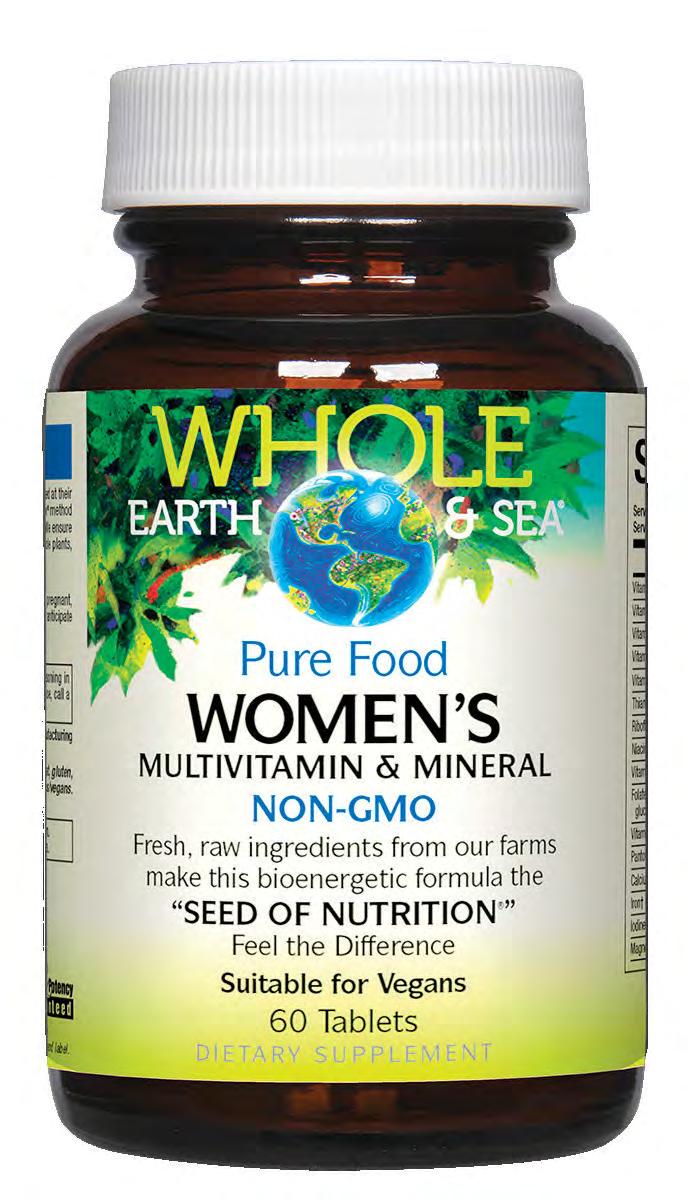

Yes, you can really see and feel the difference!
WHOLE EARTH & SEA AVAILABLE AT YOUR LOCAL NATURAL HEALTH STORE








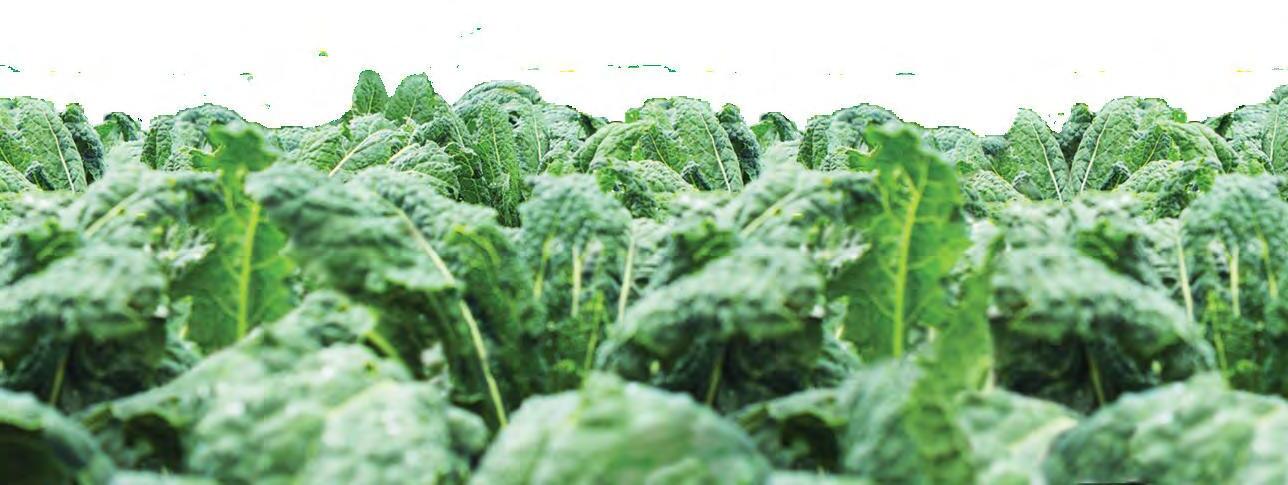



For a topic many people don’t want to talk about, sexual dysfunction has a large presence. Approximately 40 percent of women experience problems with low libido and sexual arousal, and roughly 50 percent of men in their 50s


libido, there is no pill for that. Or they may not want to take Viagra or pop a pill,” explains Dugoua. For men in their 20s or 30s, he recommends doing blood tests, as diabetes could be one of the root causes. But, Dugoua says, for the majority of men, libido issues
be super helpful,” he says.
Stress is also an issue for women, but the female reproductive cycle poses additional challenges. “Women have to contend with fluctuating estrogen and progesterone. If they are having libido issues, I start with asking if they are having
This well-known adaptogen herb is often referred to as Indian ginseng. Research suggests that it is good for both decreasing the stress hormone cortisol and slightly increasing testosterone. Dugoua recommends taking ashwagandha, particularly for people in their 20s or 30s experiencing low testosterone.
Recommended dosage: 240–500 mg per day
There are many reasons to take vitamin B-complex—keeping the nervous system healthy and boosting our mood, for instance. Studies have also shown it to play a role in hormonal balancing by helping to create and activate estrogen and support metabolism.
Recommended dosage:
vasodilator which means it helps improve blood flow. It is also thought to slow the breakdown of testosterone in the body.

Also referred to as ginkgo, this natural supplement is thought to increase blood flow. “Theoretically, it could increase blood flow to female genitals, which might help with libido. But it’s known more so for guys,” explains Dugoua.


Recommended dosage: 60–240 mg up to twice daily
A combination of approximately 1.1–1.2 mg B1, 1.1–1.3 mg B2, 14–16 mg B3, 5 mg B5, 1.3 mg B6, 30 mg biotin, 400 mcg folic acid and 2.4 mcg B12

Studies have shown this adaptogenic root vegetable may help balance hormones, improve libido and decrease sexual dysfunction in postmenopausal women. This may be in part because it is also shown to have mood-boosting and anxiety-easing properties. It is often found in libido formulas for women.
Recommended dosage: 1.5–5 grams per day
These statements have not been evaluated by the Food and Drug Administration. These products are not intended to diagnose, treat, cure or prevent any disease.
This mineral has been shown to help regulate hormones, including testosterone. Zinc deficiency has been linked to erectile dysfunction and lower sperm counts.
Recommended dosage: 15–30 mg of zinc picolinate (thought to be easier to absorb than other types)


regular periods,” Dugoua says. If there is irregularity, then there is a possibility for the presence of polycystic ovary syndrome (PCOS), which can cause estrogen levels to fall and raise testosterone levels. Likewise, for older women facing menopause, they face a dramatic drop in estrogen, which is linked to low bone mass, acid reflux and heart disease. When women have a lot of estrogen, it can increase the risk of breast cancer, and low testosterone can diminish sex drive. “We help women manage their hormones,” Dugoua explains.
For both men and women, there are some baseline lifestyle habits that can aid in a healthy sex life. In addition to managing stress, good sleep habits are very important. “A lot of people overlook sleep. But sleep is key to having healthy testosterone levels and managing
stress. You build testosterone at night,” explains Dugoua. Regular exercise can also help with blood flow to the genitals; Dugoua notes that strength training in particular can help bump up testosterone. A healthy diet is also important. Dugoua recommends zinc-rich foods such as shellfish, pumpkin seeds, walnuts and asparagus, which can bolster testosterone. And foods such as antioxidant-rich berries are good for circulation and protecting the inner linings of blood vessels.
Dugoua recommends several natural supplements to help with sexual dysfunction. Here are just a few that Dugoua recommends. As always, it’s important to consult with a healthcare specialist to make sure you are taking supplements to match your specific needs.
Cicero’s favorite supplement for heart health is magnesium.
“It is associated with reduced blood cortisol level (the stress hormone) and reduced blood pressure,” he says, which is important because blood pressure is a strong risk factor for cardiovascular disease. Research also suggests that magnesium may improve cholesterol levels and prevent heart disease, heart failure and stroke. A 2019 analysis found that the highest magnesium intake reduced stroke risk by 11 percent.
Recommended dosage: 200 mg/day chelated magnesium (a form that is more easily absorbed)


It’s a sobering fact: Heart disease is the number one cause of death both in the U.S. and worldwide. But, according to the American Heart Association, a full 80 percent of cardiovascular disease is preventable. Arrigo Cicero, M.D., Ph.D., a cardiac researcher and professor at the University of Bologna, says that we know many of the risk factors for cardiovascular disease—and also how to manage them. He advises to not smoke; get regular exercise; focus on eating whole grains, vegetables, fresh fruits, nuts and fish; and avoid excess salt, processed meats and trans fats. He also recommends reducing stress, managing insomnia and adopting a pet(!), all of which are associated with improved heart health. Additionally, he recommends these heart-supportive supplements.
The news has been back and forth on fish oil and heart health, but recent research is once again touting its benefits. An updated 2019 metaanalysis of 13 randomized, controlled trials and more than 127,000 participants found that marine-derived omega-3s significantly reduce risk of heart attack, stroke, cardiovascular disease and death. Cicero suggests supplements with EPA (eicosapentaenoic acid) specifically—which may improve circulatory health, help regulate heartbeat and may reduce cardiovascular inflammation.
Recommended dosage: 1,000 mg/day EPA

Beetroot extracts are a “natural source of nitrates and are associated with reduced blood pressure and improved vascular and heart functionality,” says Cicero. A 2021 trial on healthy males found that taking beetroot extract before exercise improved heart rate recovery, and a 2020 review paper reported that the blood pressure lowering effect of beetroot juice is “significant” in people with normal blood pressure and even more considerable with high blood pressure or obesity.
Recommended dosage: 200–400 mg/day

Widely thought to lower cholesterol and reduce the risk of major cardiac events, red yeast rice is made by fermenting white rice with a yeast called Monascus purpureus, creating a reddish colored rice. In a 2019 research paper, Cicero reported that this rice reduces LDL (bad) cholesterol by as much as 25 percent. He suggests taking it combined with phytosterols (which studies have found have an additional cholesterollowering effect) or the Chinese herb berberine (which also reduces triglycerides). Do not use red yeast rice if you take statin drugs or are intolerant to statins, says Cicero, as red yeast rice has similar effects.
Recommended dosage: 1,200–2,400 mg/day, divided into two to three doses



Ancient Nutrition Collagen Peptides is made with clinically studied ingredients to bring you whole-body benefits – from your skin, hair and nails to your joints and gut. †










Available in select stores.
†These statements have not been evaluated by the Food and Drug Administration. This product is not intended to diagnose, treat, cure or prevent any disease.



























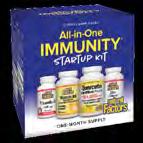
“To help create a just-right inflammatory response for the immune system, you have to have vitamin D,” says McLemore. “It’s one of the few substances that increase T-regulatory cells, which are the main determinant in inflammation,” she explains. Vitamin C is also a powerful antioxidant, she says, reducing oxidative stress and inflammation.
A2020 study of people in 27 countries found that the most pressing health concerns right now are COVID, mental health, cancer, stress, obesity and diabetes, all of which have a common link: inflammation. “Inflammation, simply put, is the root cause of all disease, whether that’s pain, immune system dysfunction, metabolic syndrome, autoimmune disease, you name it,” says Jennifer McLemore, L.Ac., an acupuncturist and Chinese herbalist in Boulder, Colorado, who sees inflammation-related concerns in just about all her patients.



Inflammation is an essential process. The immune system uses a healthy amount of inflammation to respond to and help heal illness and injury. “If you were to get a cold or an injury, it’s the same exact pathway for inflammation,” says McLemore. The trick is achieving just the right amount of inflammation to keep the immune system functioning optimally. Unfortunately, our modern lifestyle tips the balance toward too much of it.
The number-one driver of too much inflammation is a poor diet, says McLemore. For a healthy inflammatory response, she advises reducing sugar and alcohol, and choosing a diet rich in whole foods.
Recommended dosage: Vitamin D 2,000 IU daily (get tested first); vitamin C 1,000 mg once or twice daily
Used for thousands of years as a medicine, turmeric is thought to offer quicker recovery from fever, cough and sore throat.
“Out of all the herbs used to decrease inflammation, turmeric has the most methods of action on the body—therefore it has the strongest effect,” says McLemore. “It is also one of the best and most thoroughly studied herbs for inflammation.” Avoid it if it causes stomach upset, she says.
Recommended dosage: Start with 500 mg twice daily up to 1,000 mg three times daily, with food
“There are so many reasons to recommend NAC, considered the master antioxidant,” says McLemore. NAC is the main precursor to glutathione, and “pretty much every toxic thing we do to our body depletes our glutathione levels,” she says, which stresses our immune system and can lead to disease. Now being studied in clinical trials to protect against COVID, proper glutathione levels are crucial for staying well.

Recommended dosage: 600 mg once or twice daily
While opinions about fish oil have varied in recent years, interest is renewed. A 2020 review found not only is it antiinflammatory, but it may also help prevent viruses from entering the body in the first place. A 2019 clinical trial suggests that enriched marine-derived fatty acids increased immune response for up to 24 hours. McLemore also suggests trying cod liver oil because it’s naturally rich in vitamin D and not chemically altered.
Recommended dosage: Follow label instructions




